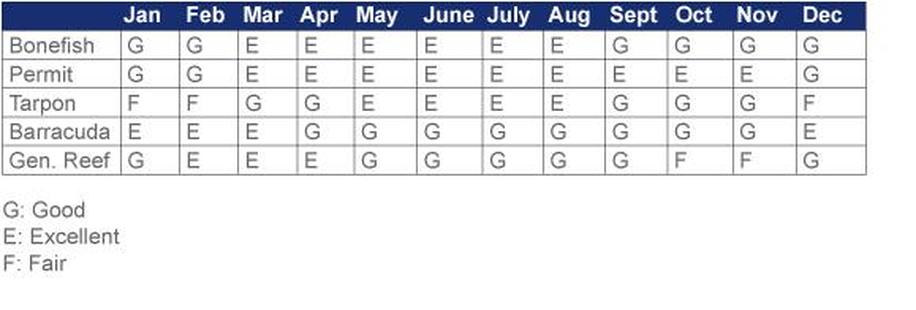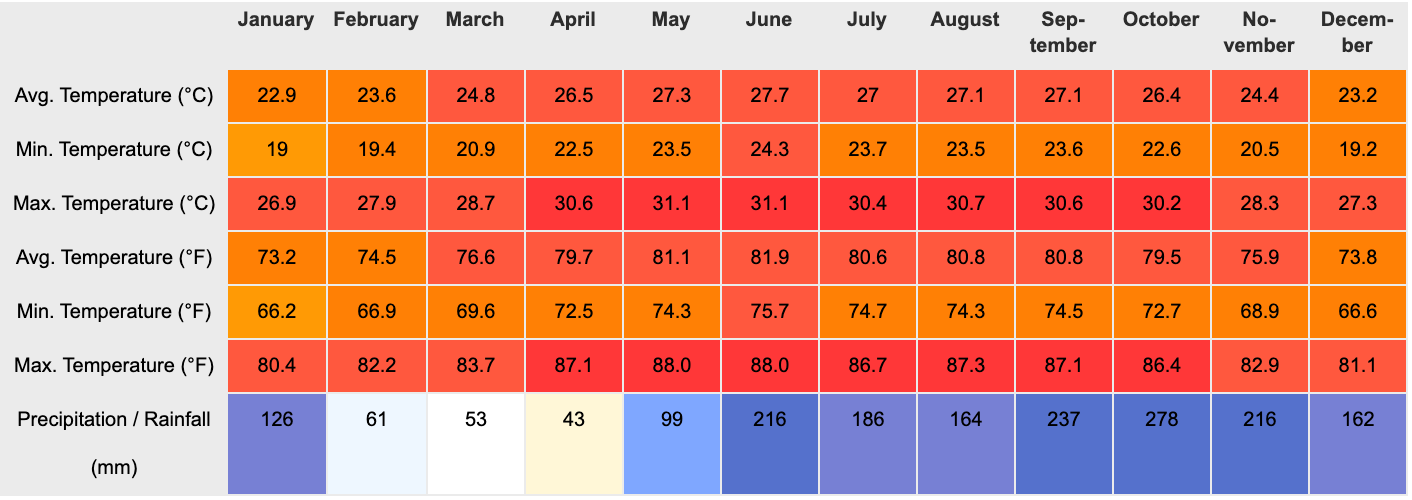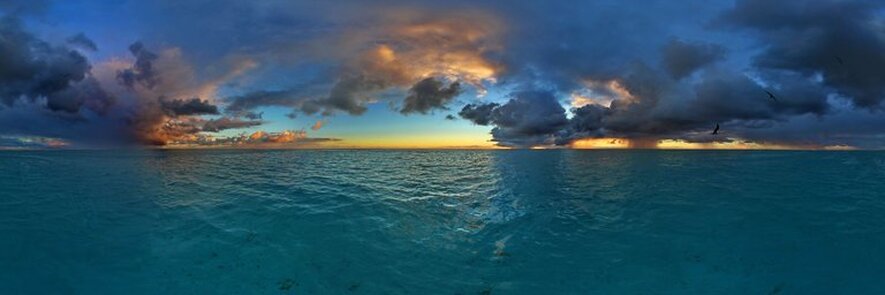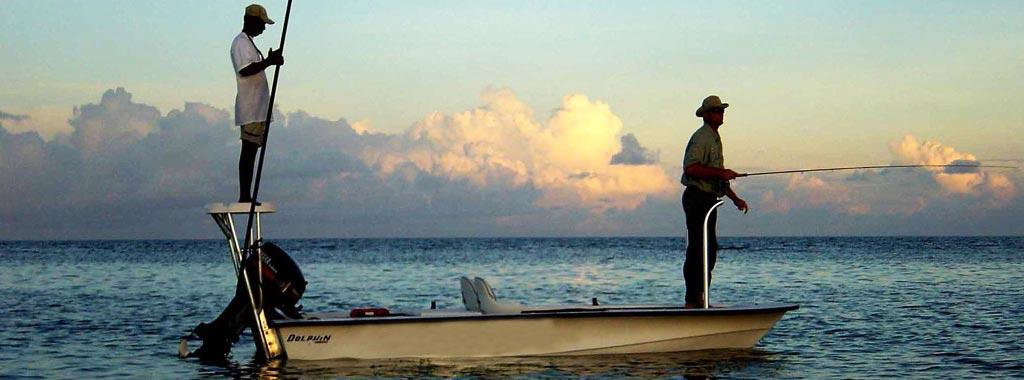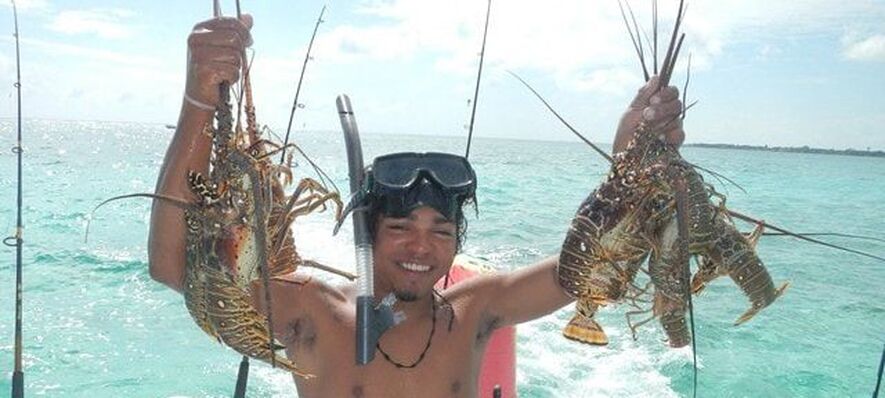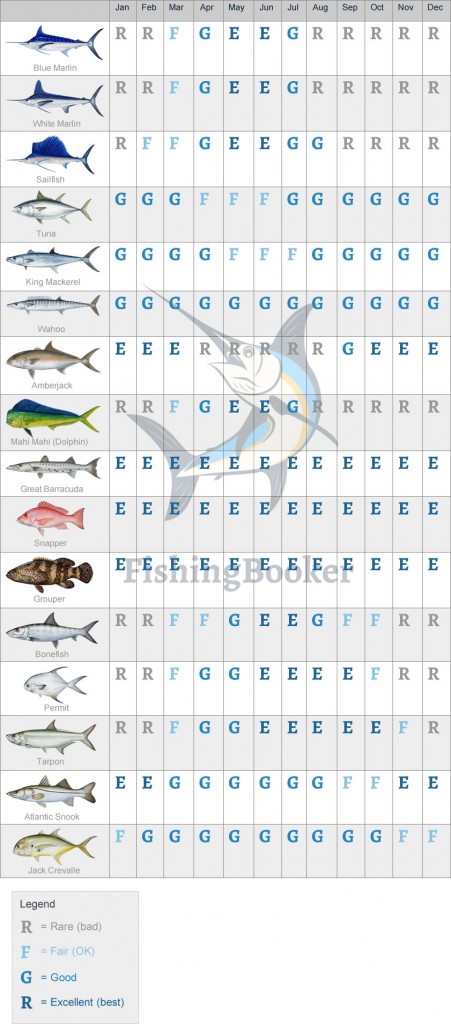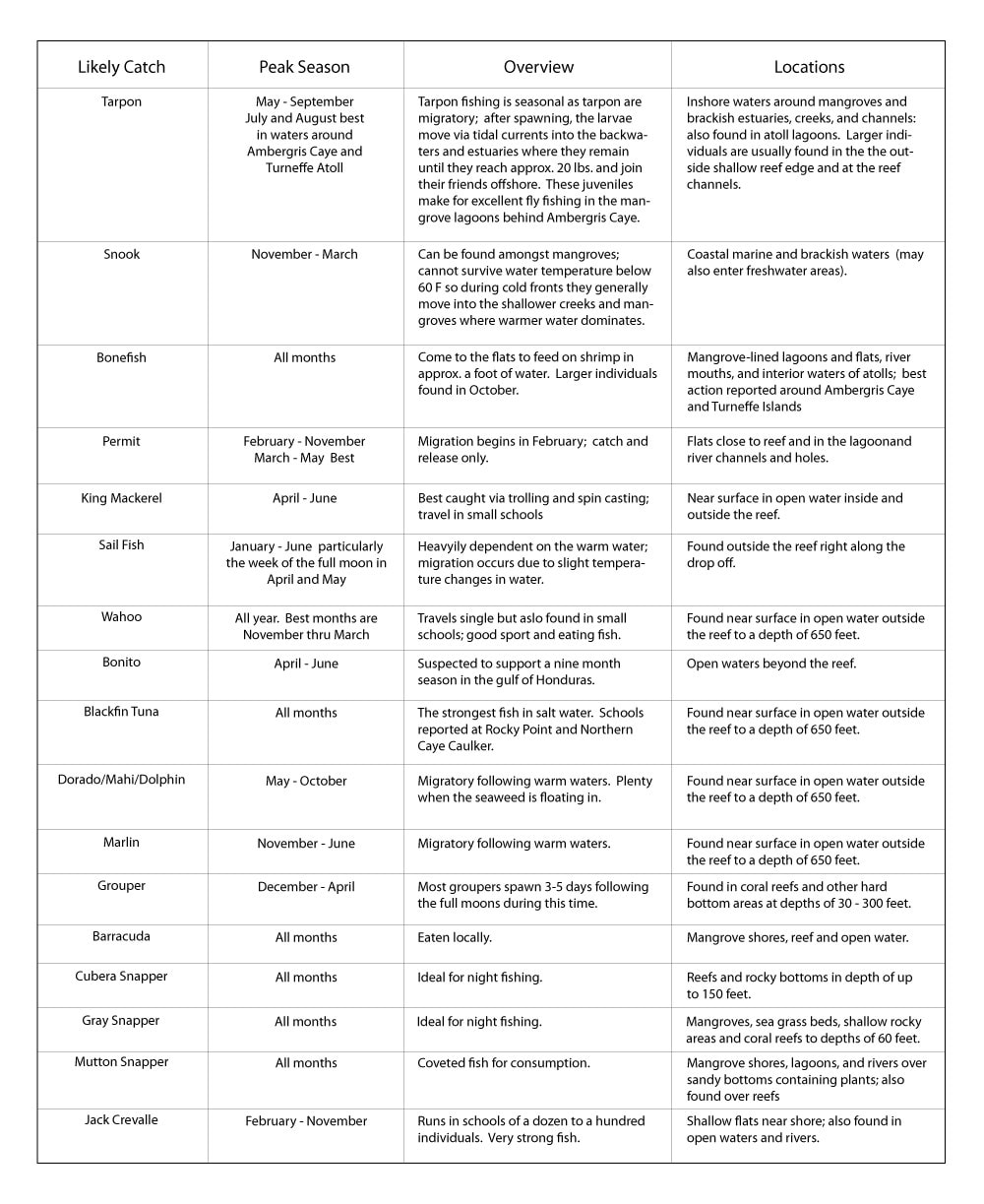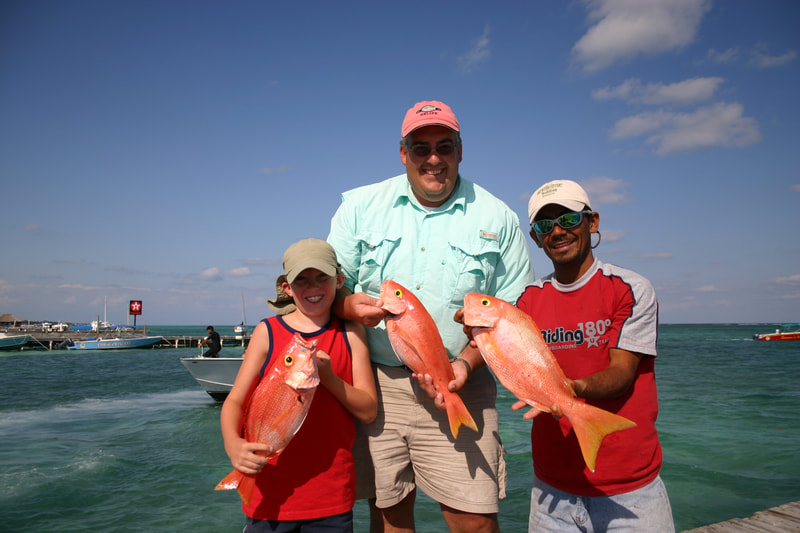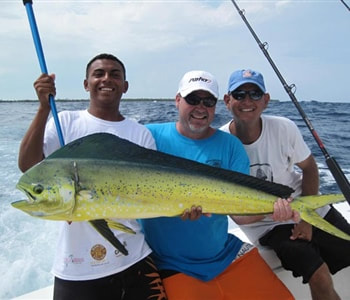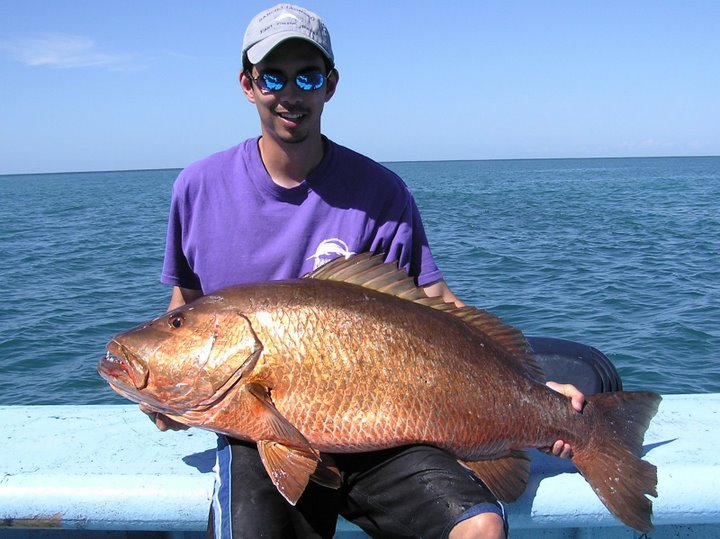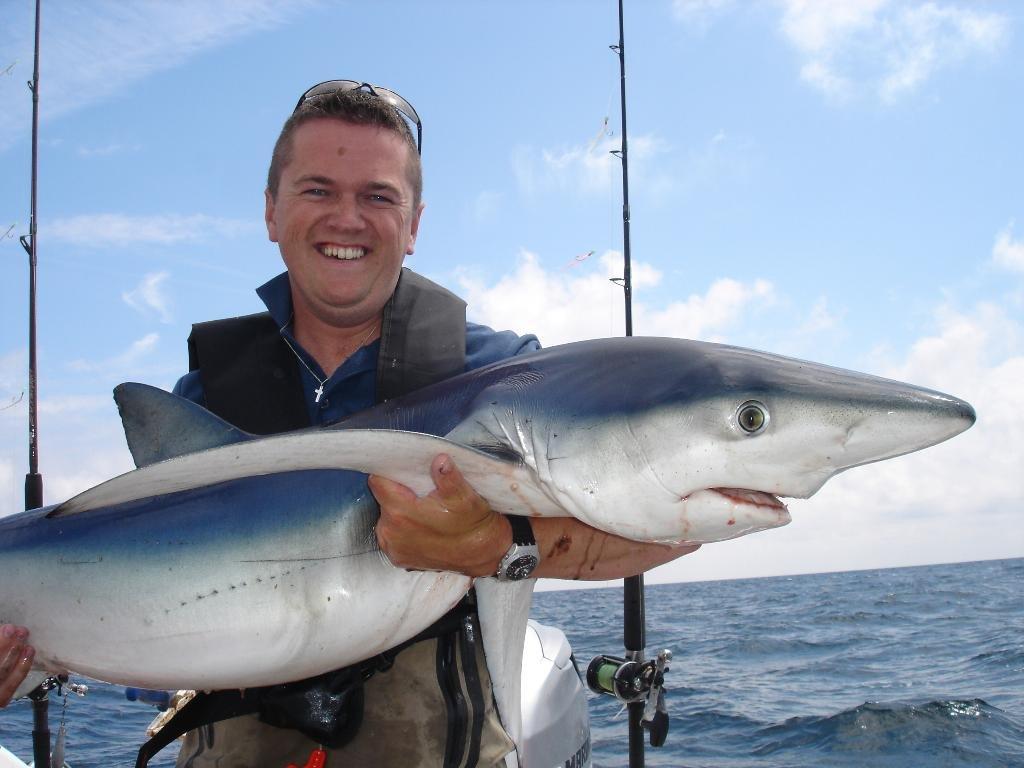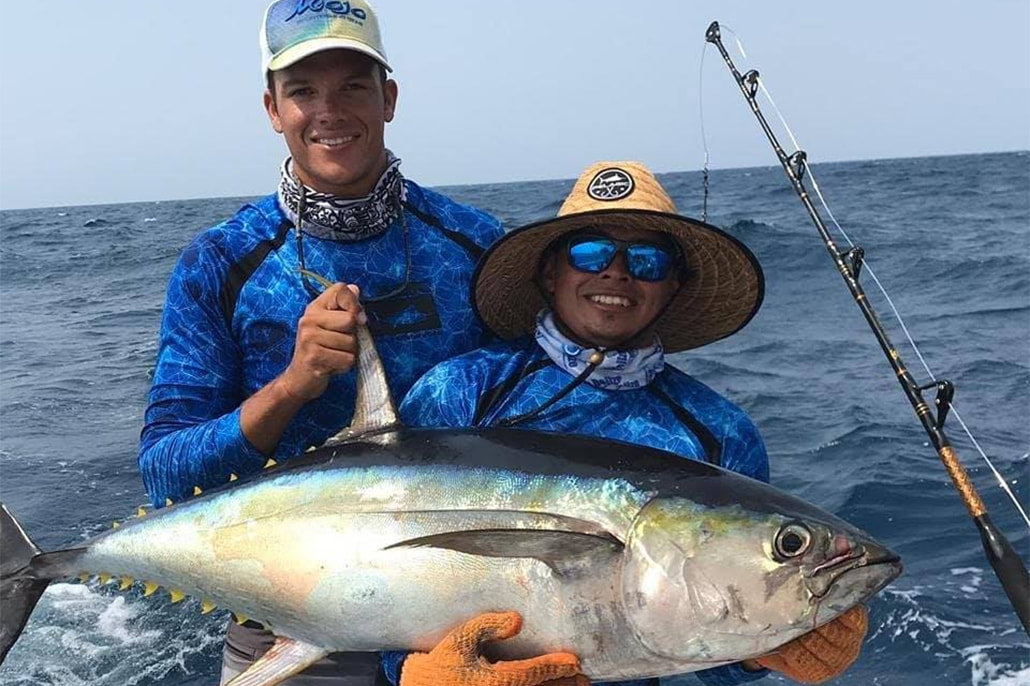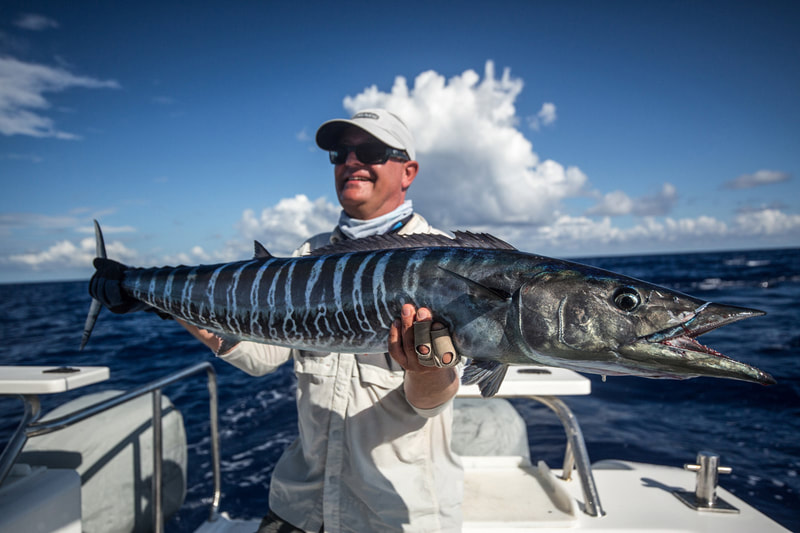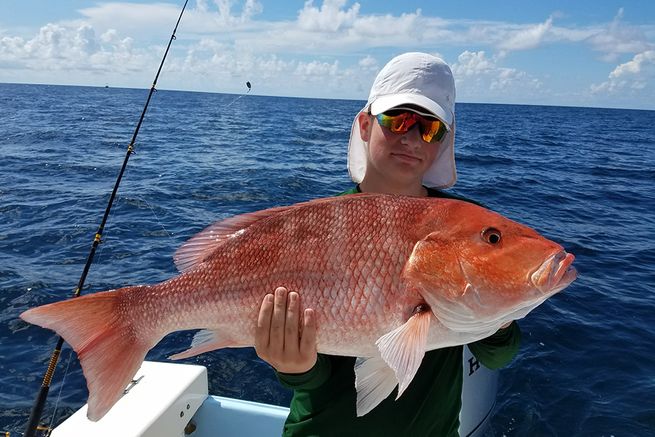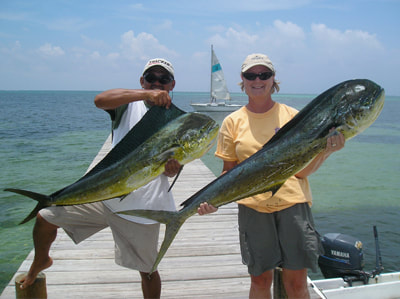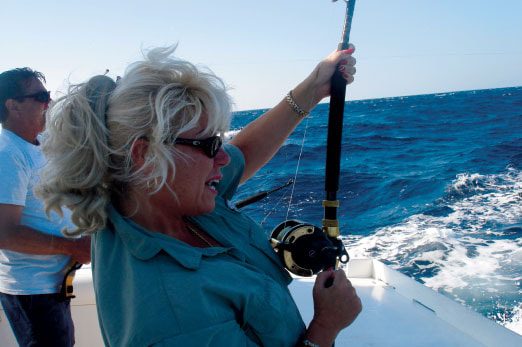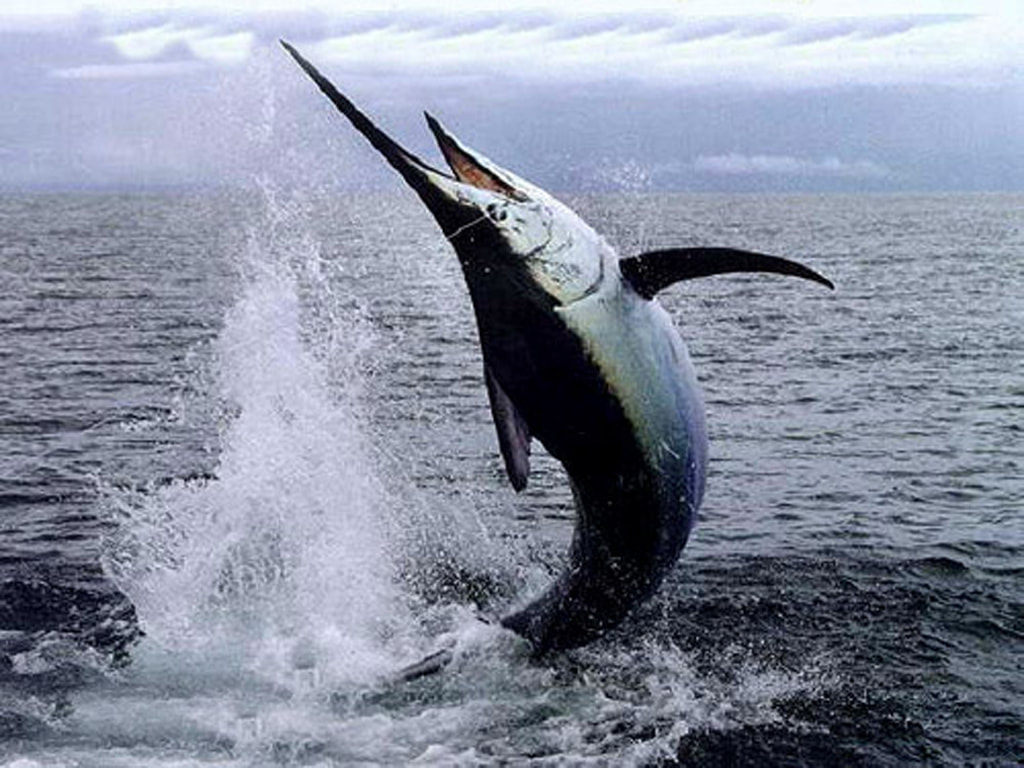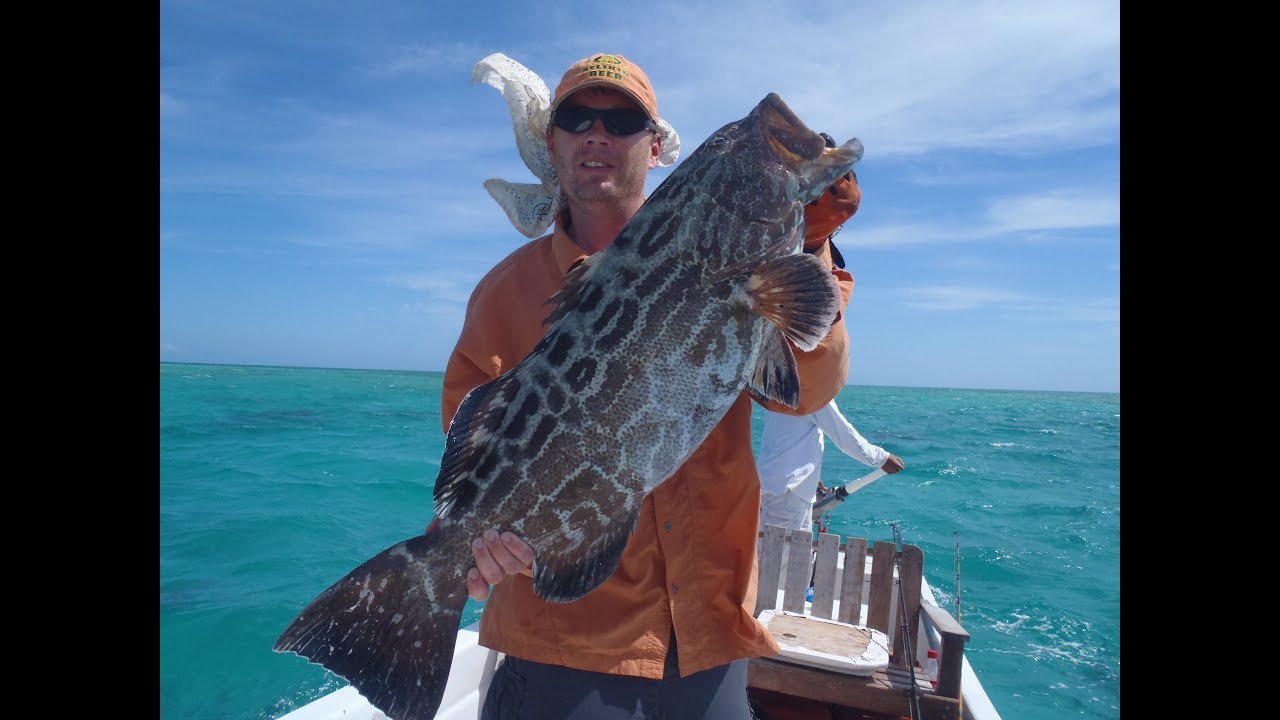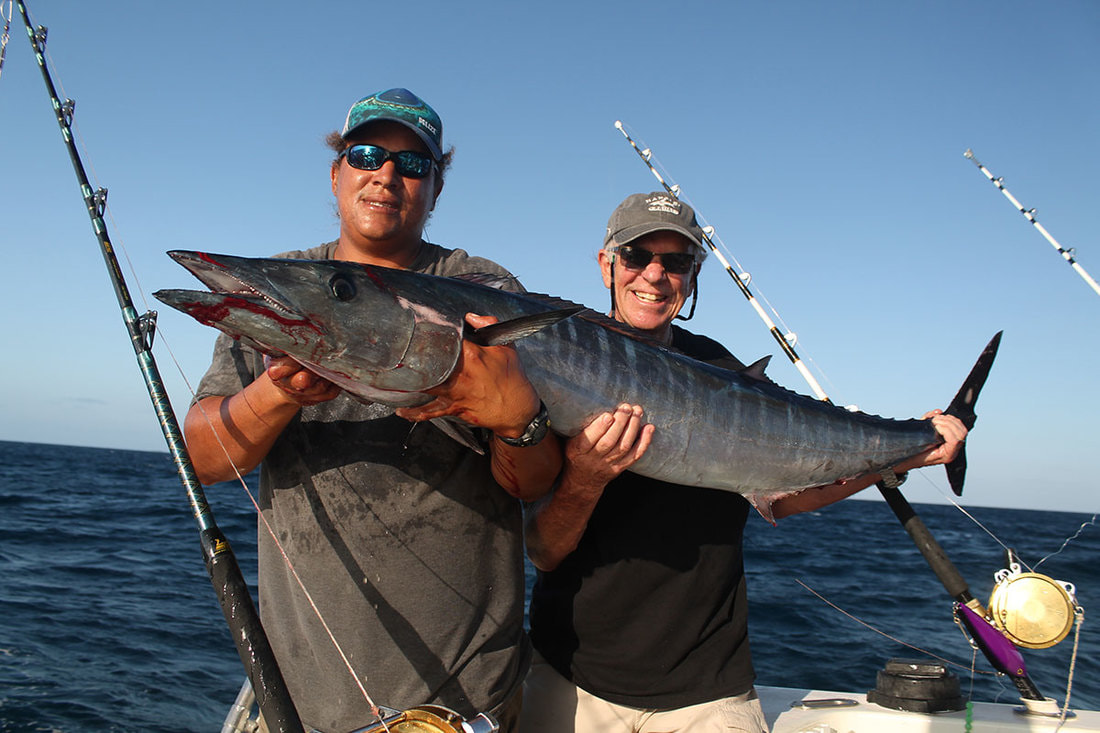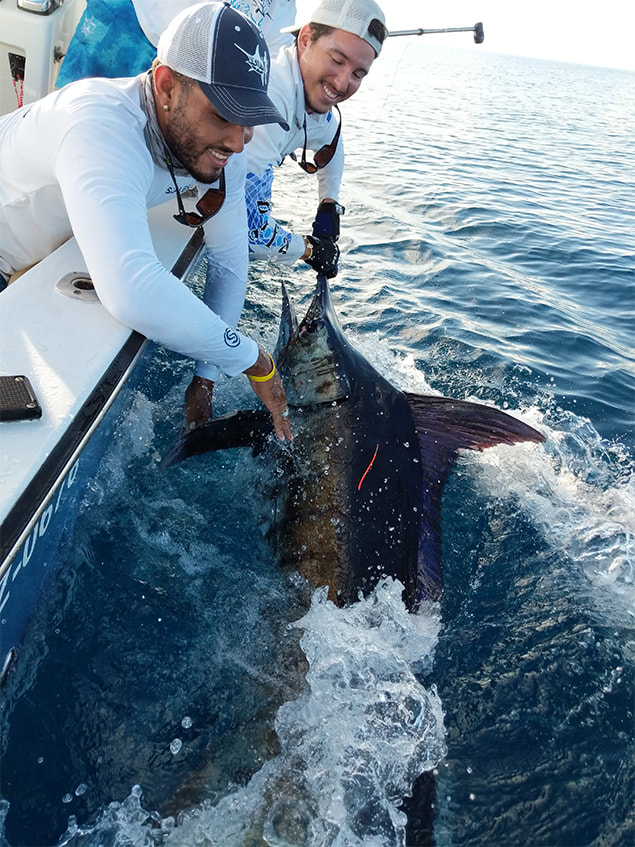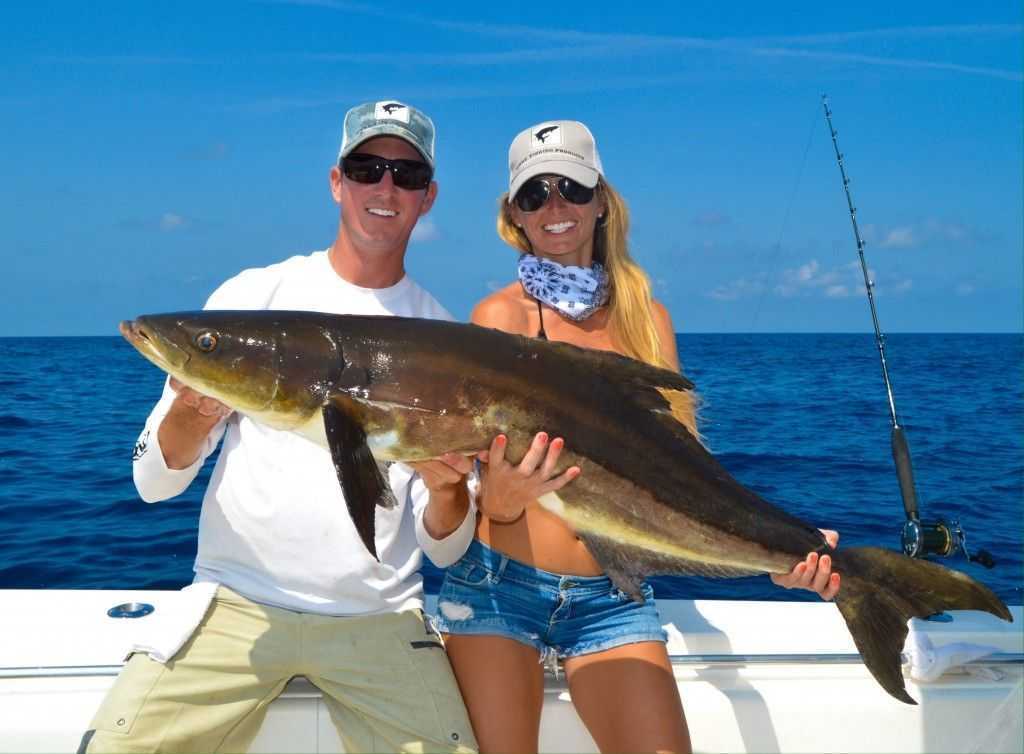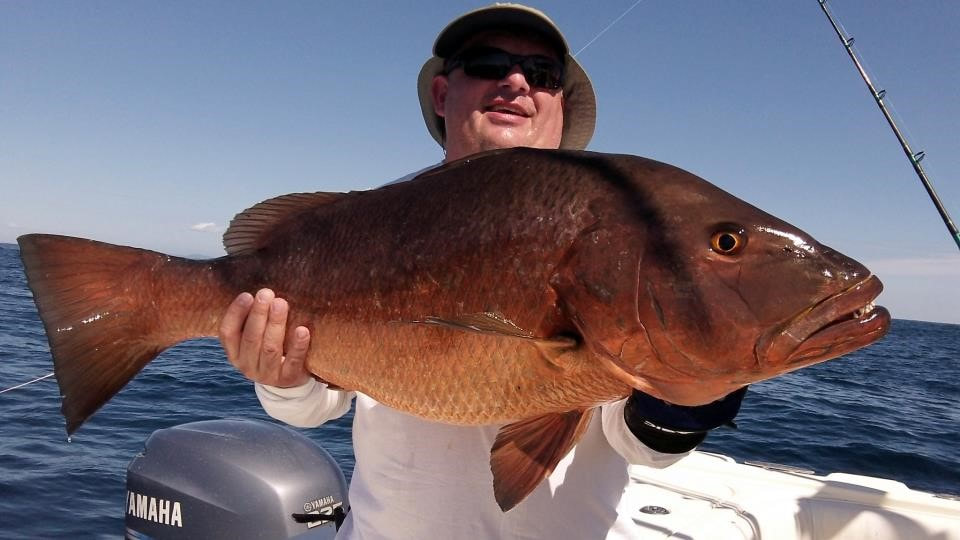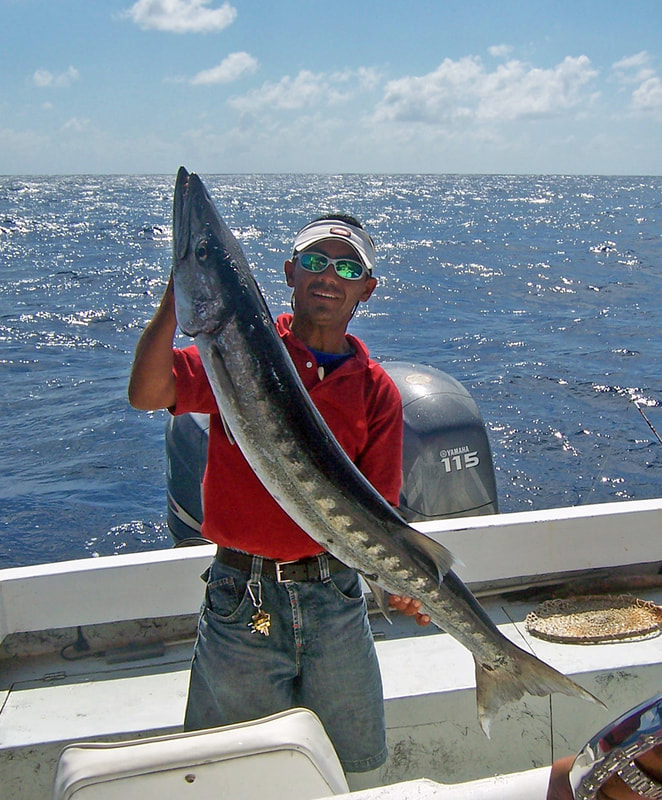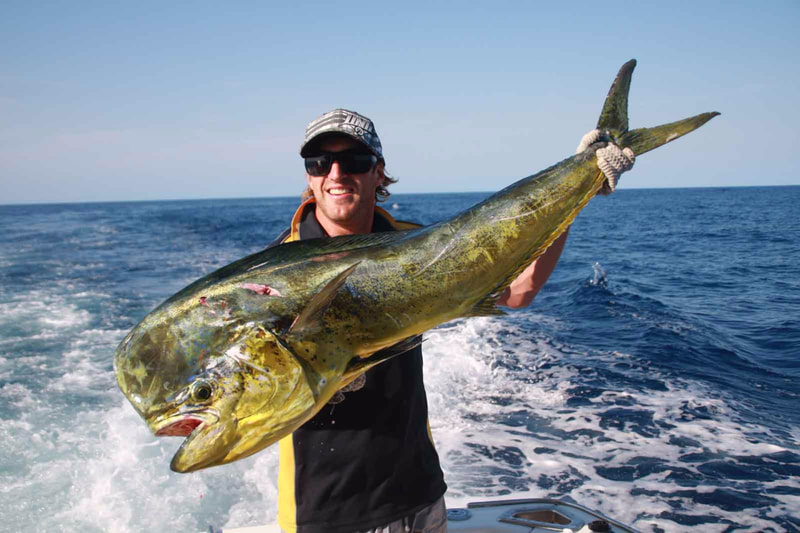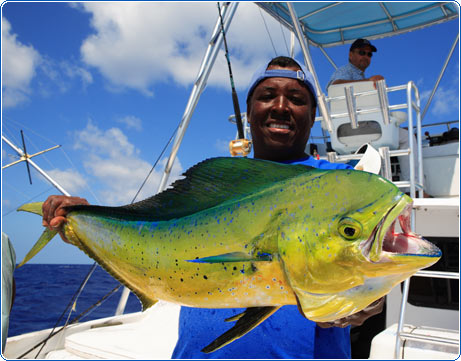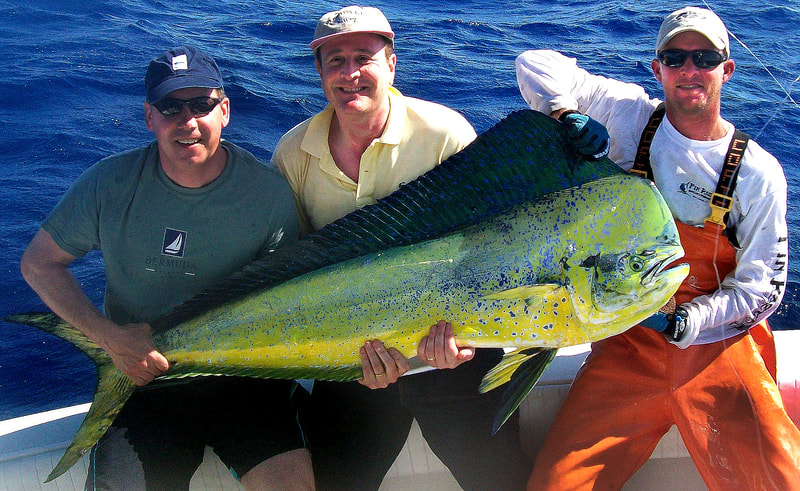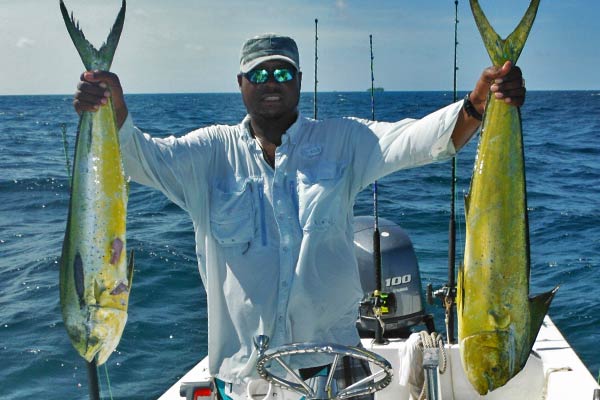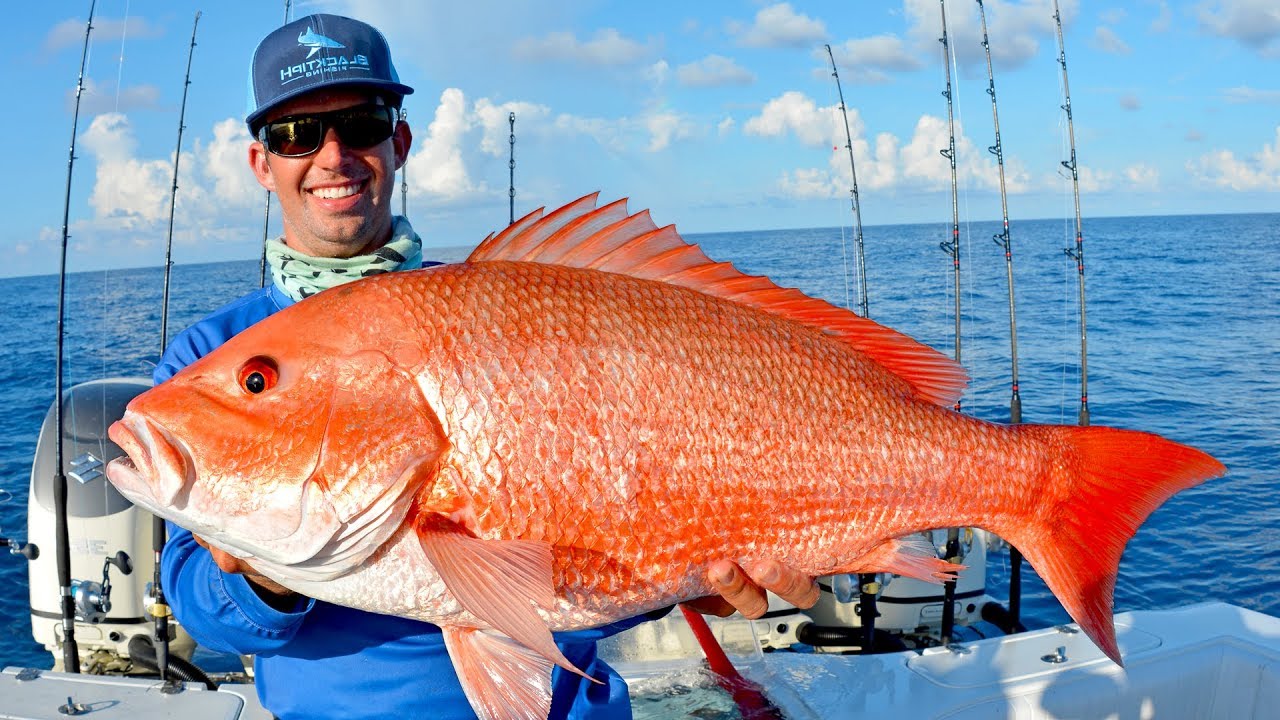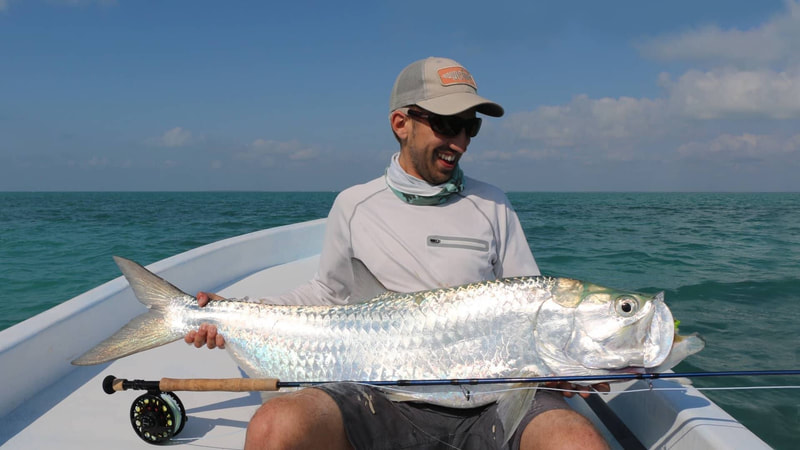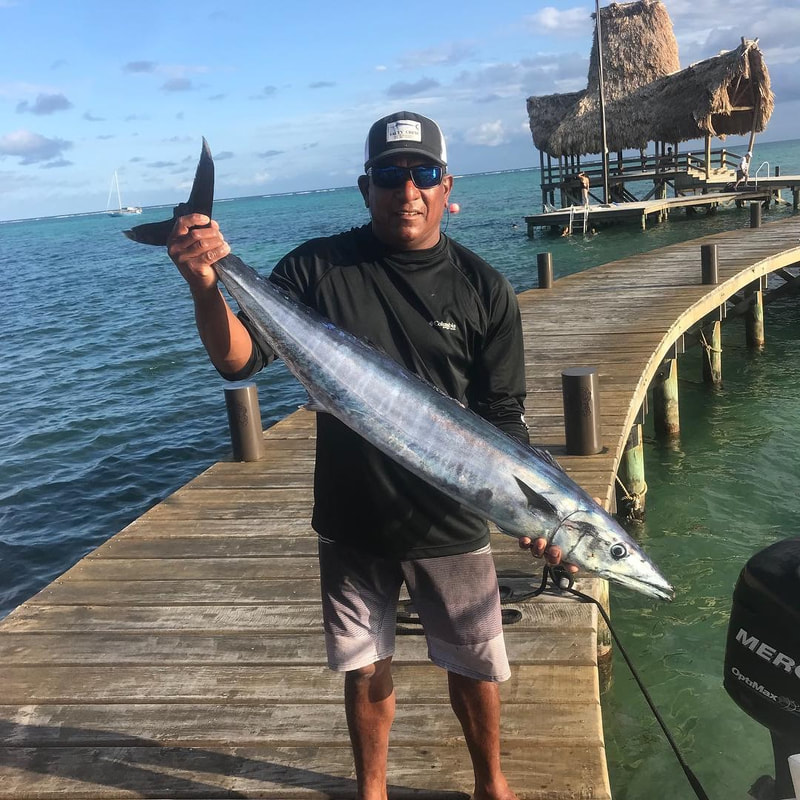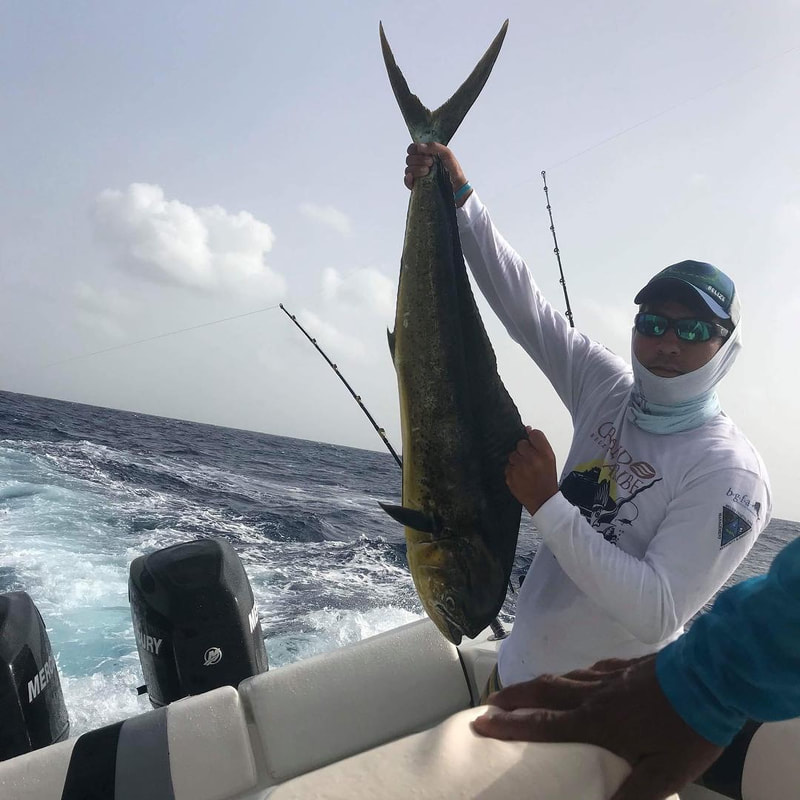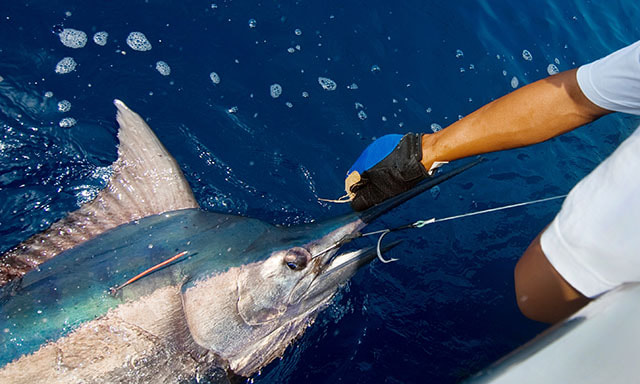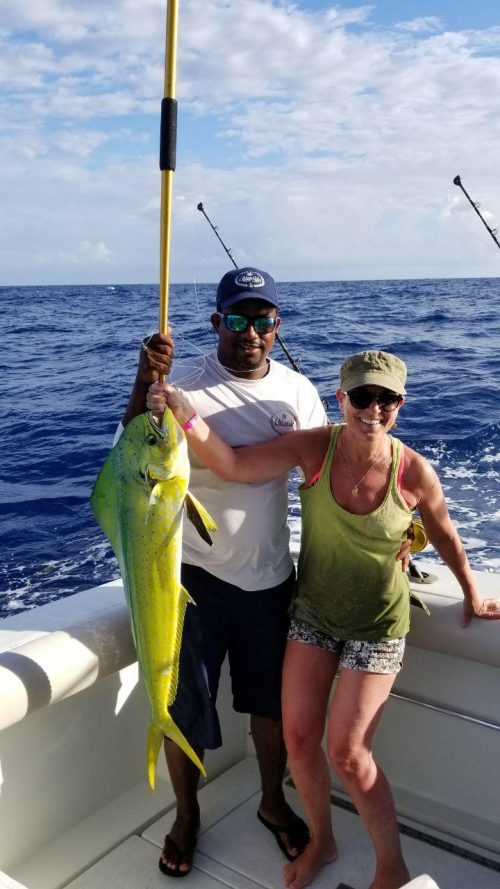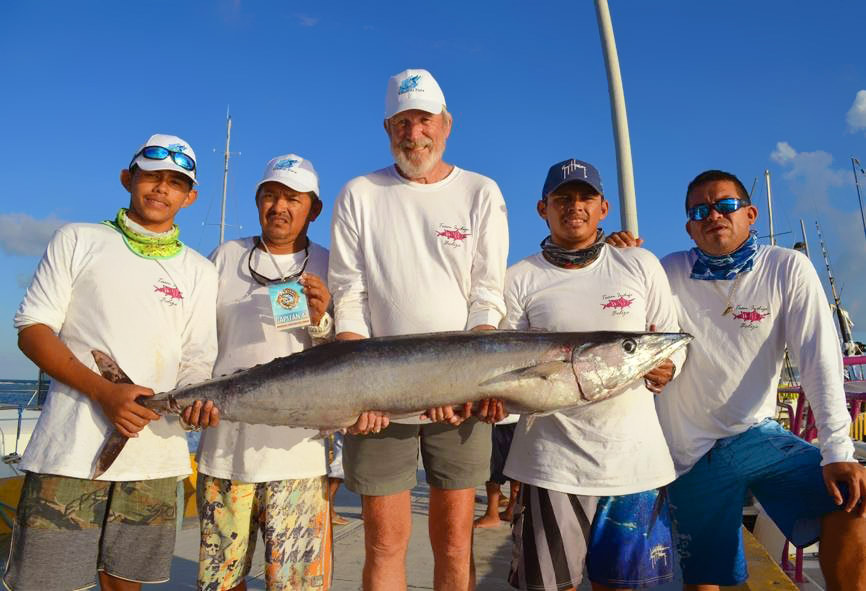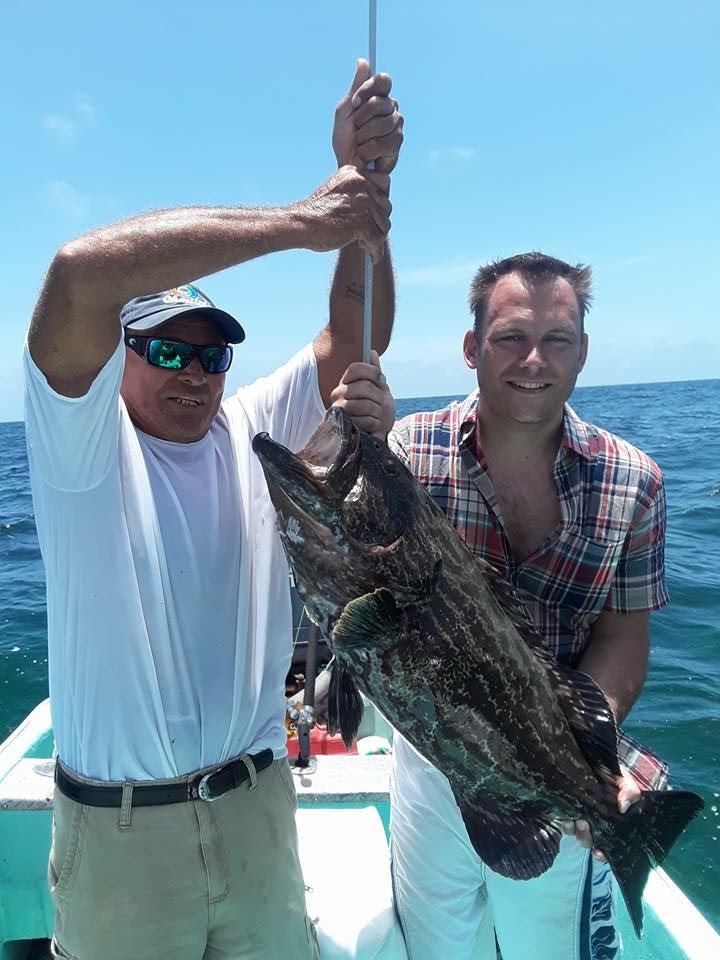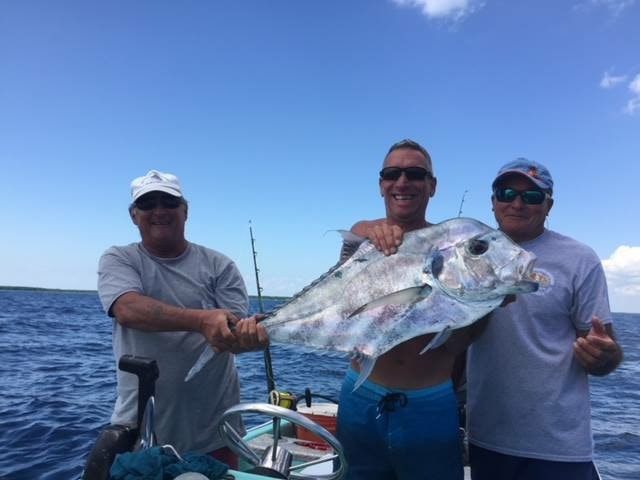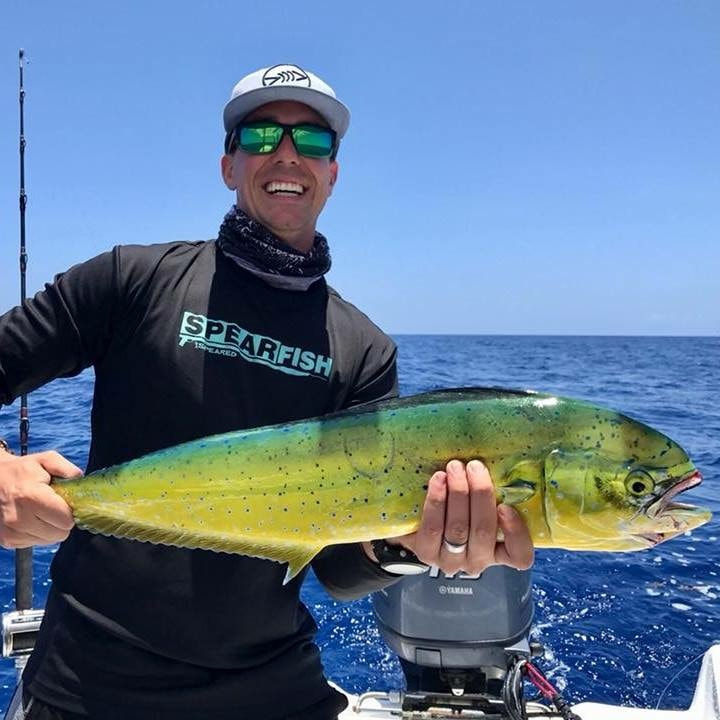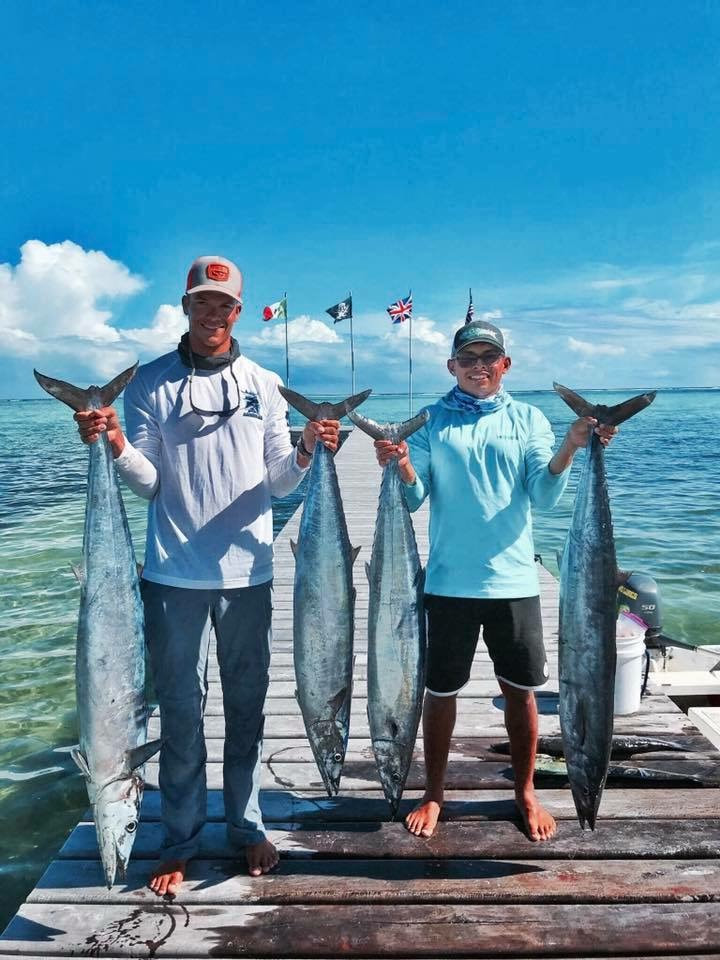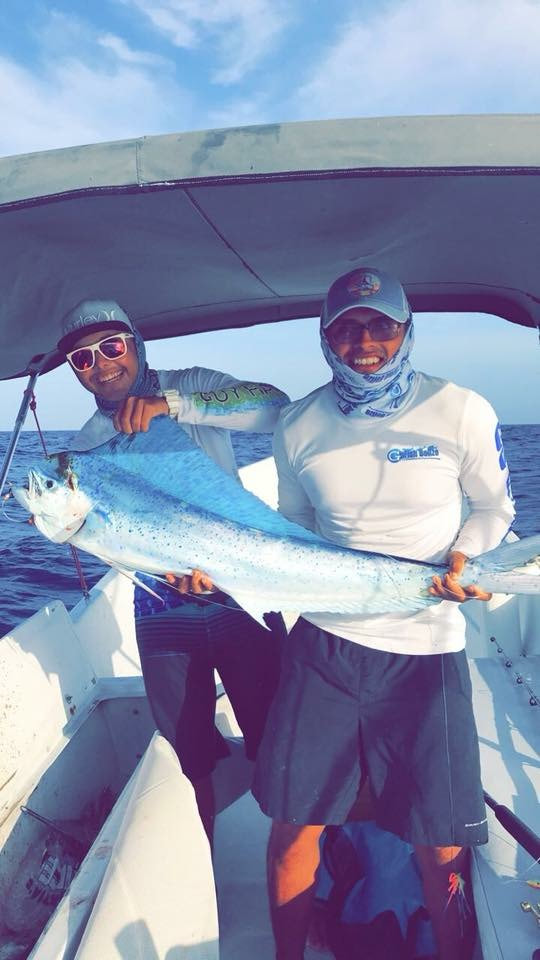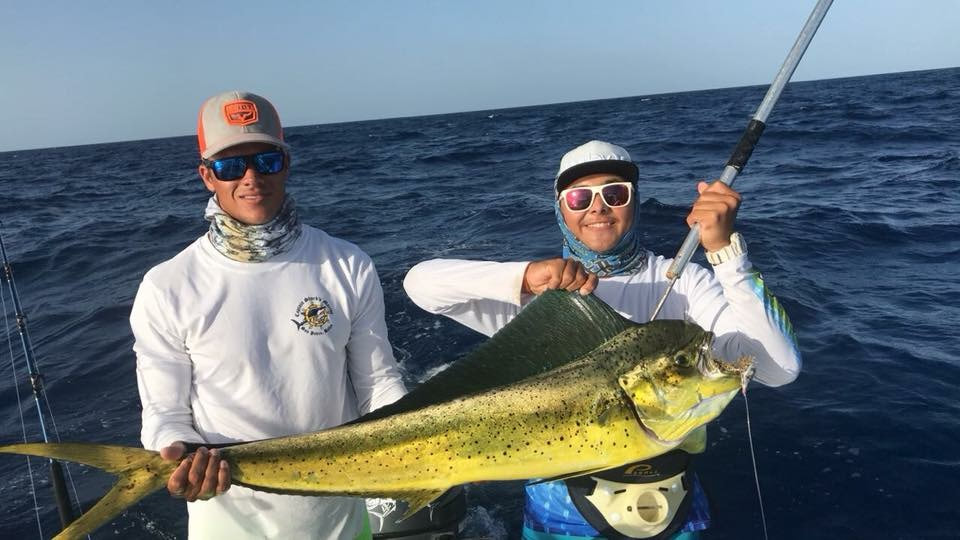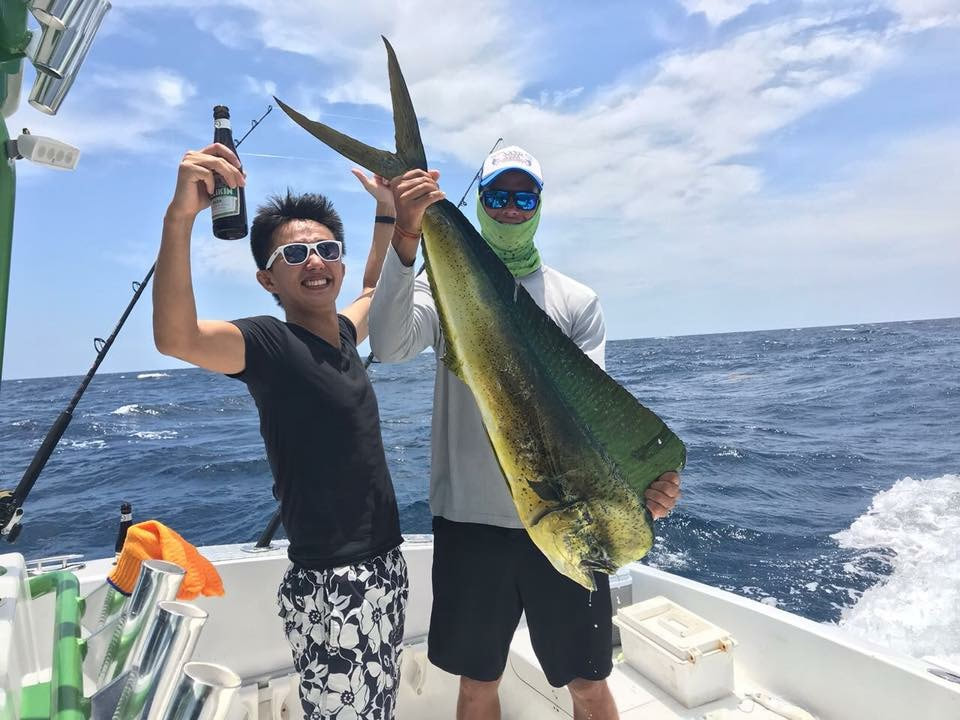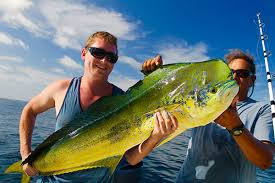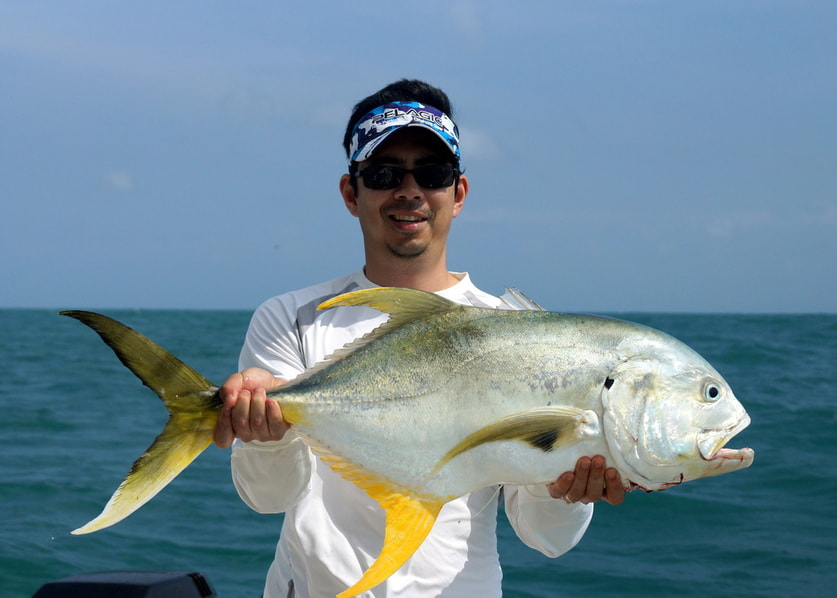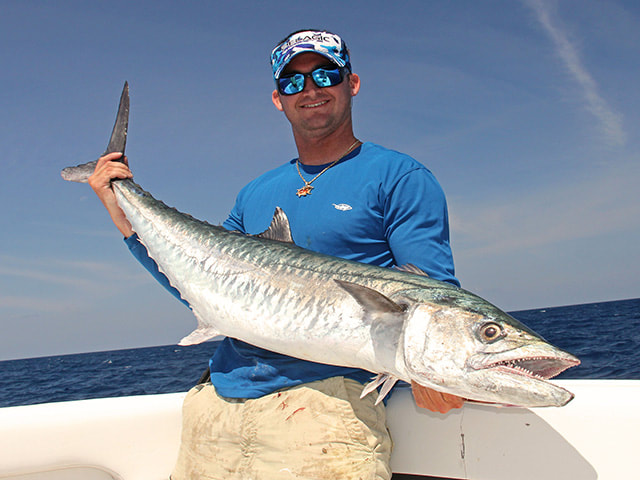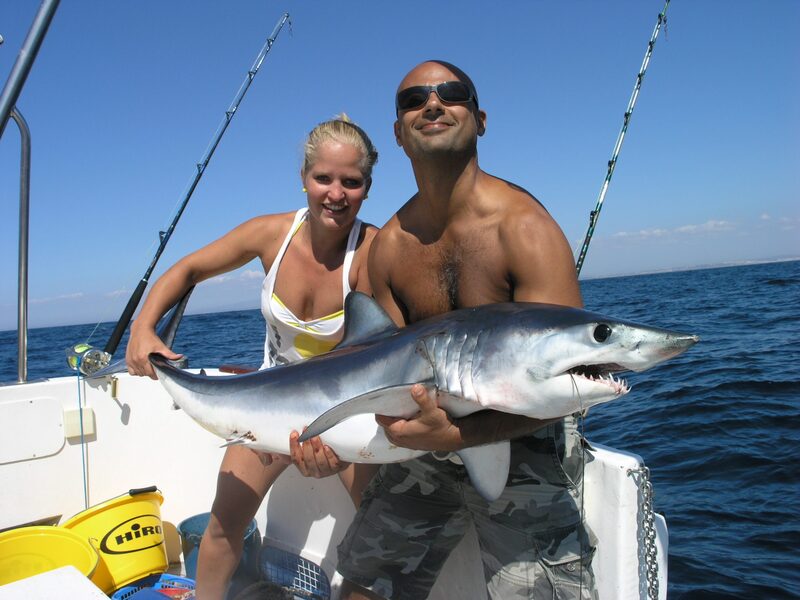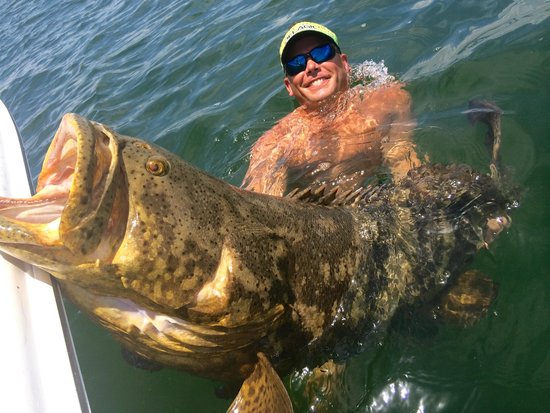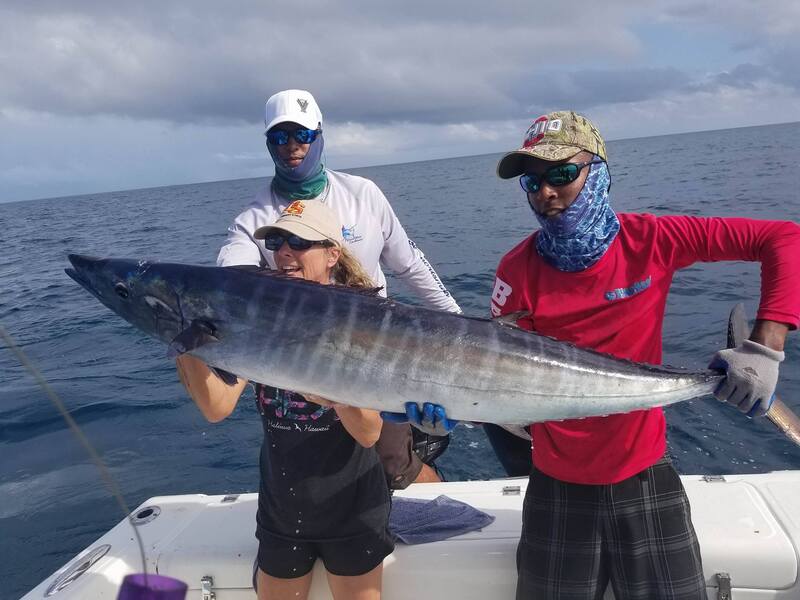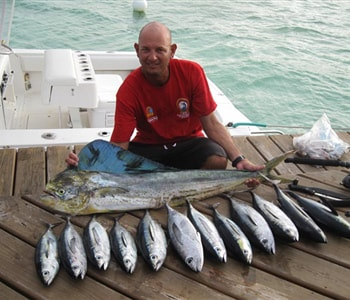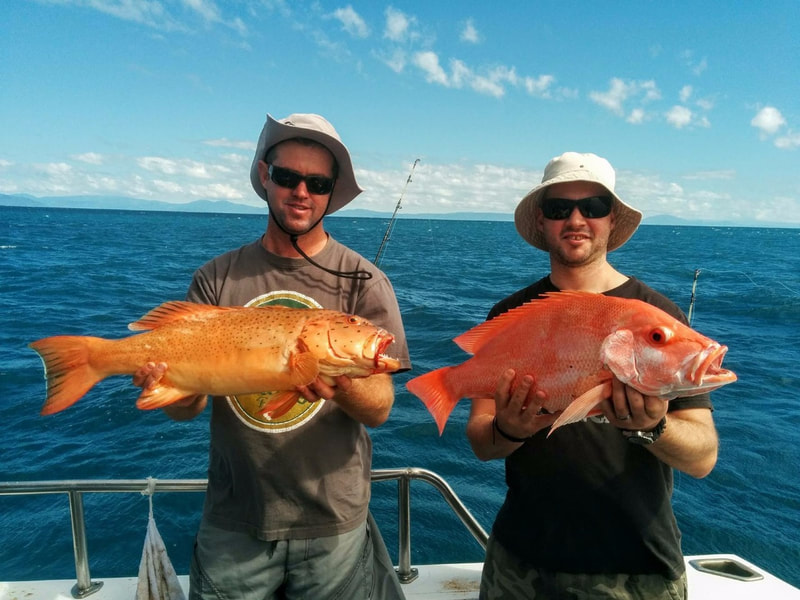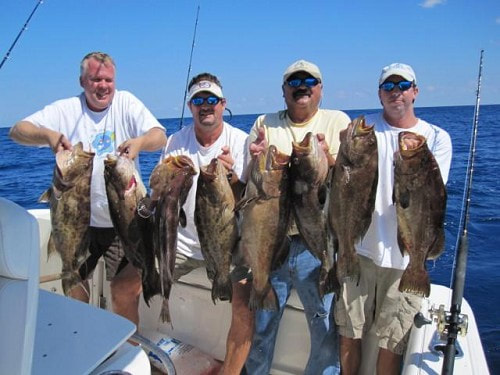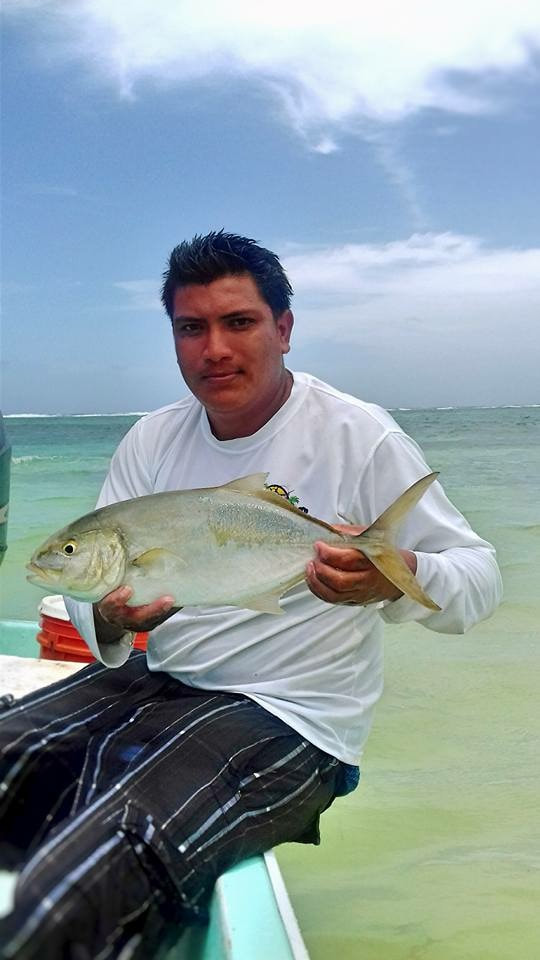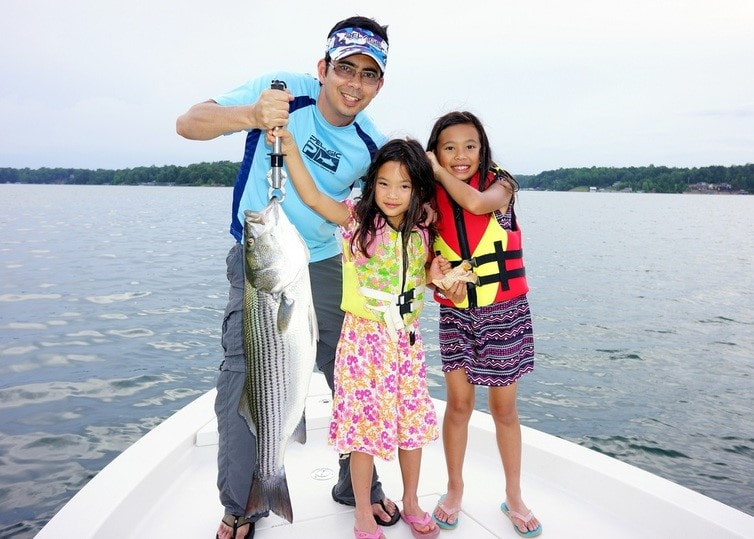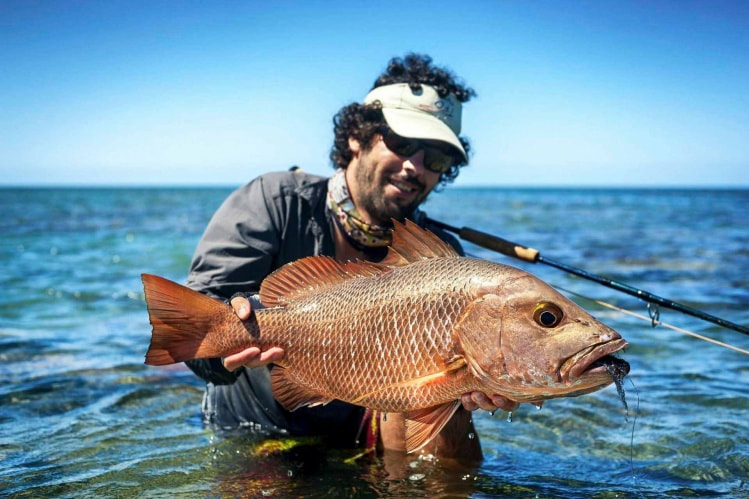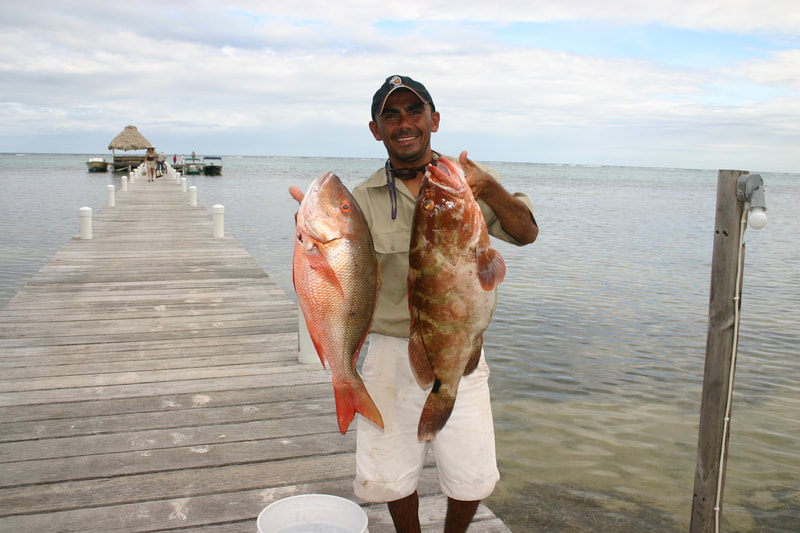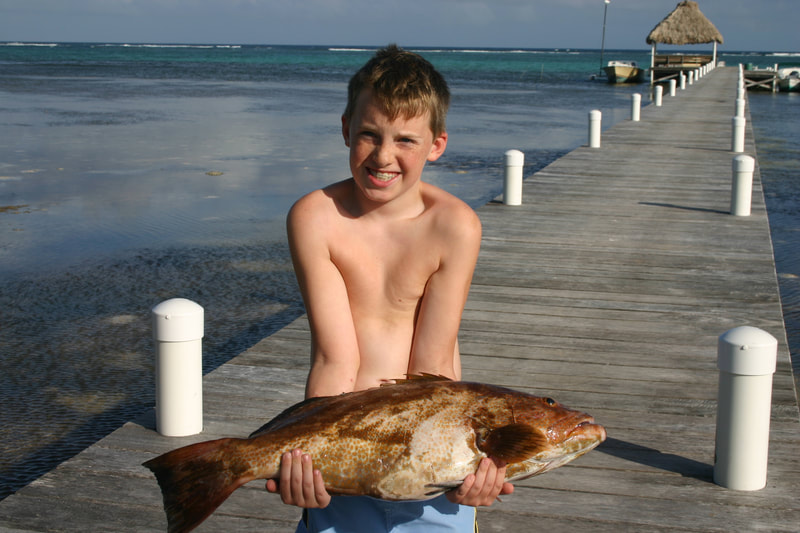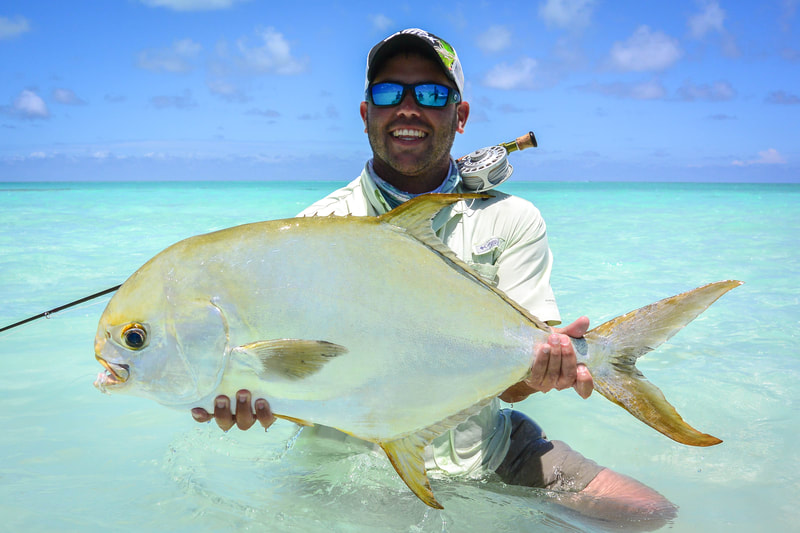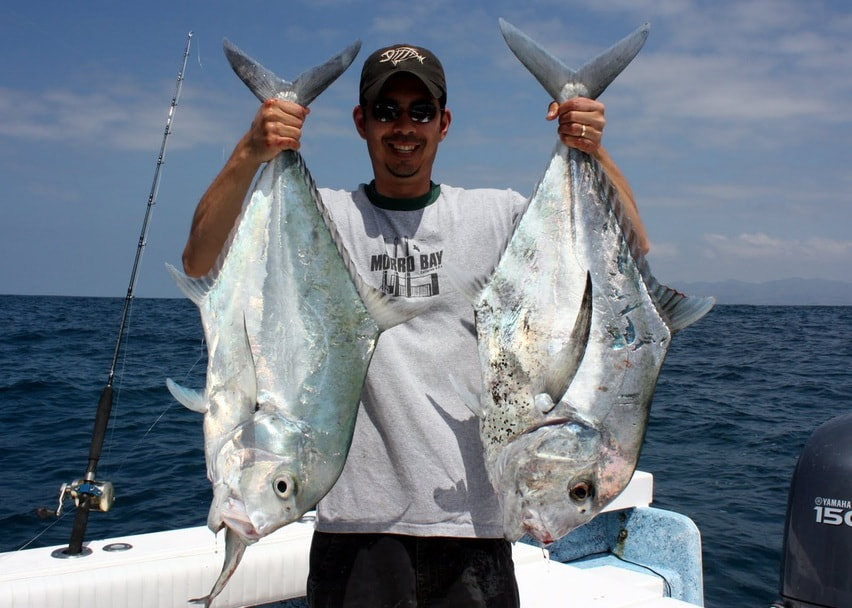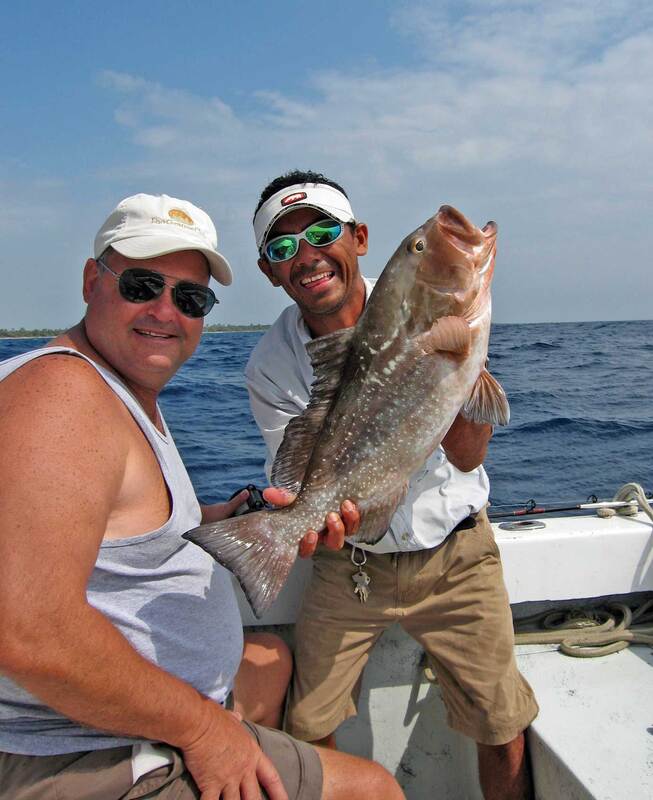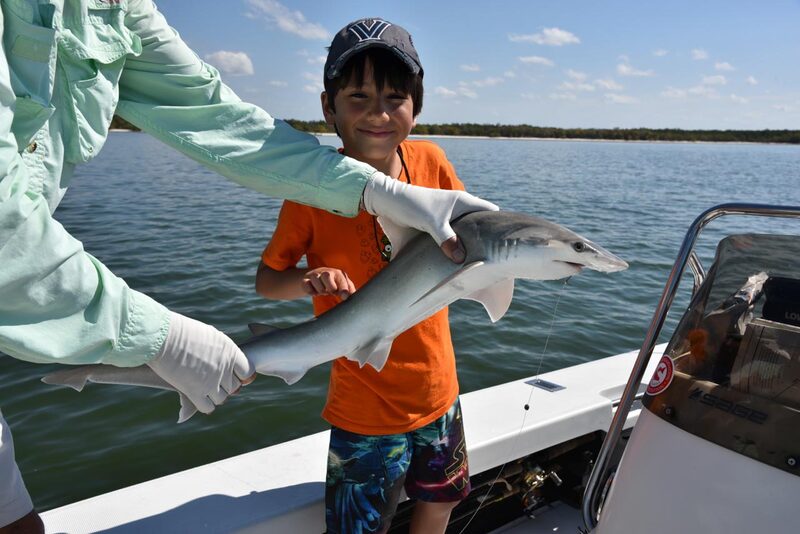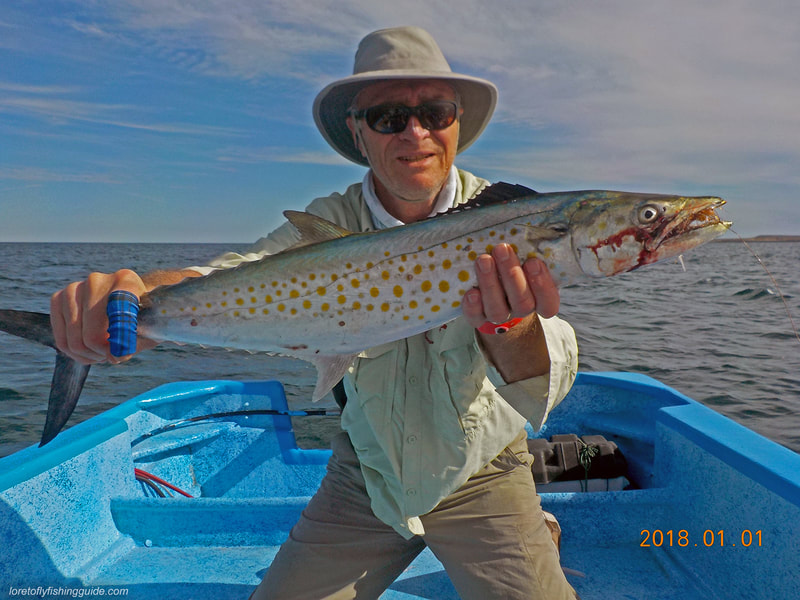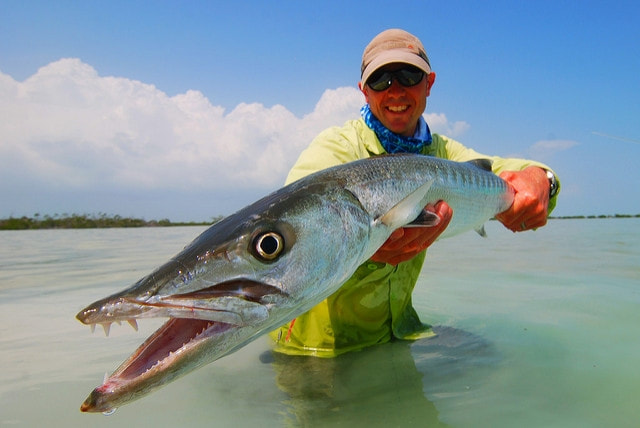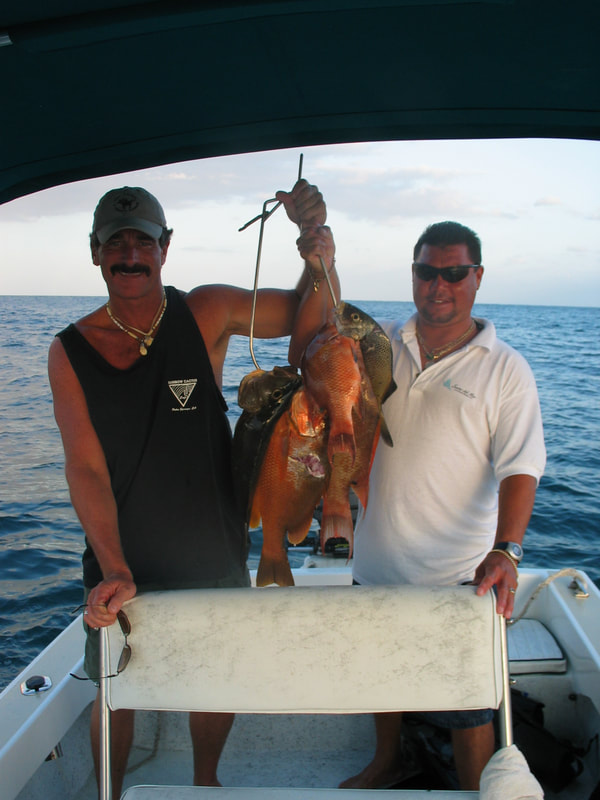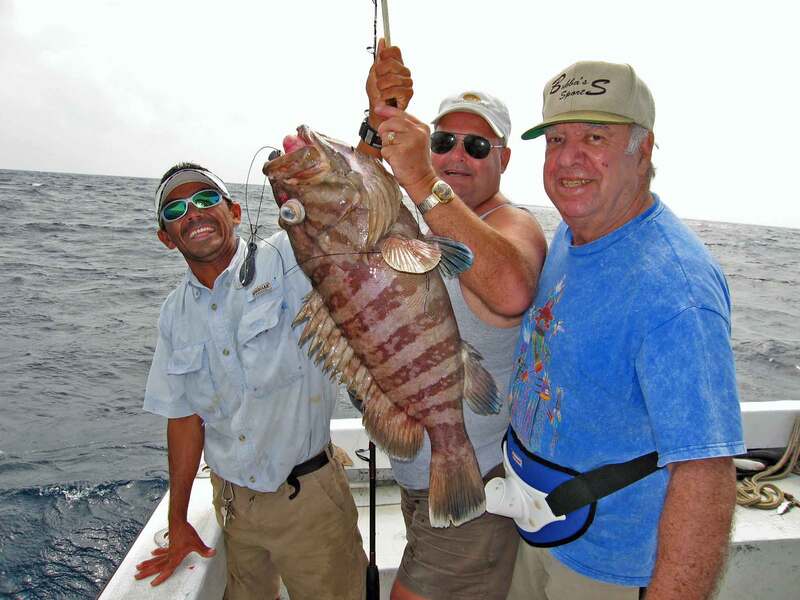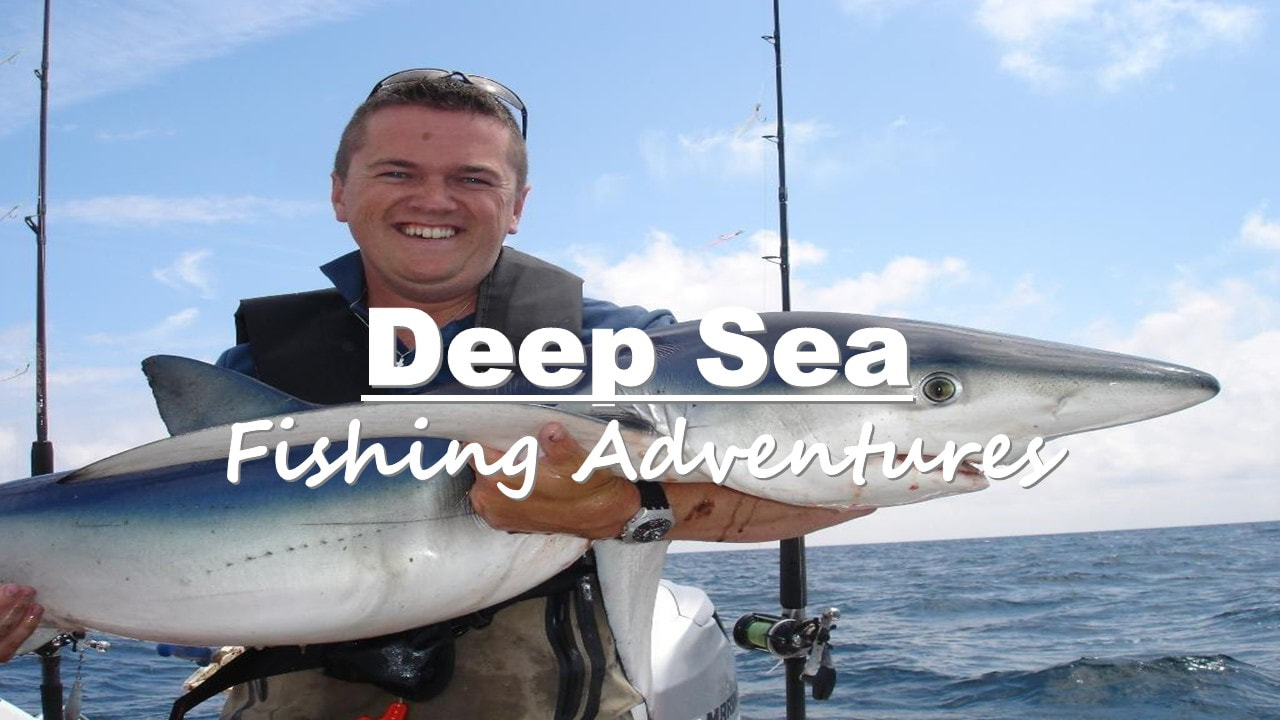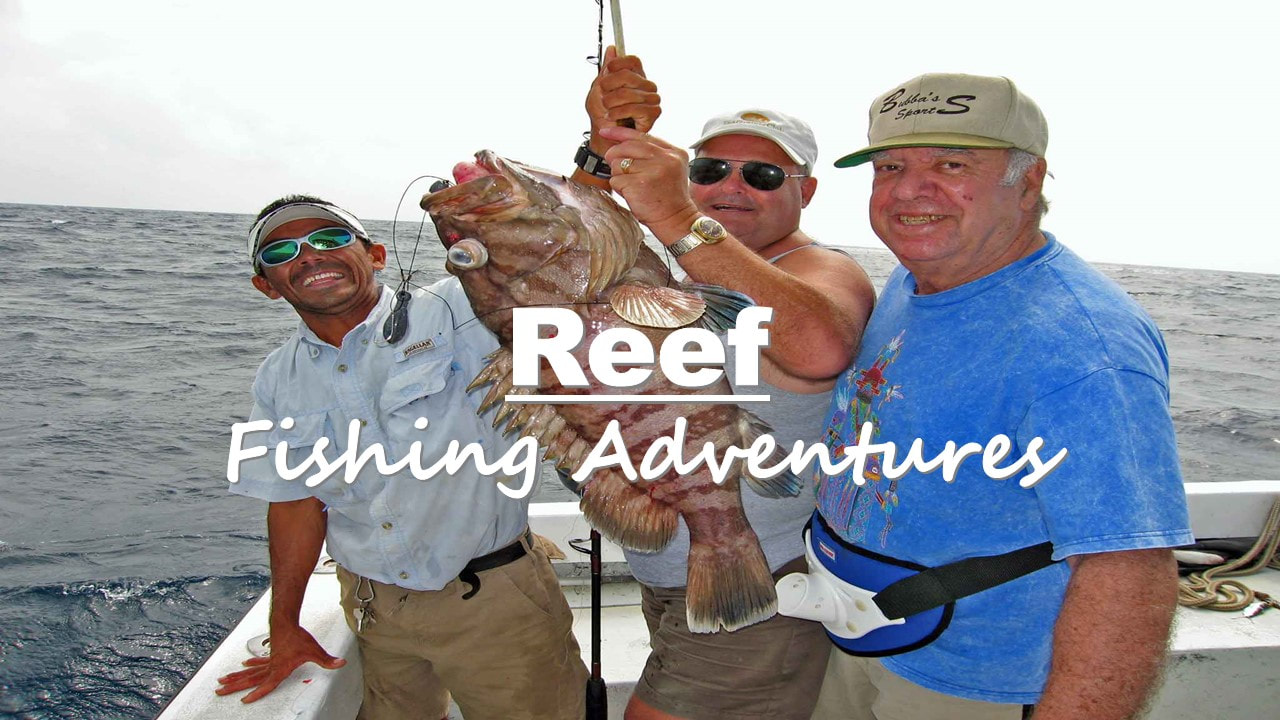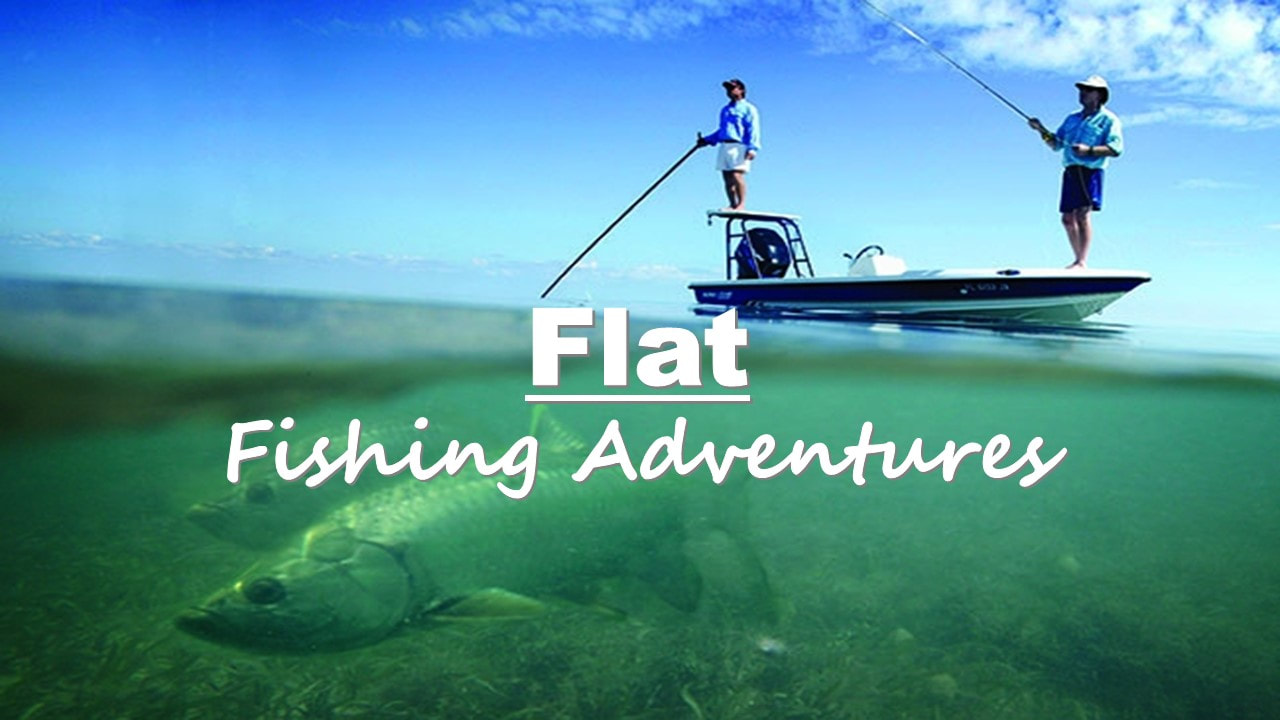Champion Fishing Within Minutes From Shore
What Time of Year is Best?
Belize has many secrets, not the least of which is this: there are fish in Belize. Fish so big and so plentiful that even the most amateur angler can catch his limit in a few hours. Fish so anxious to impale themselves on a hook that they will rush toward a skiff, or toward a pair of human legs wading in the flats (so it seems).
Belize owes its fishing phenomenon to a remarkably diverse underwater world - its boasts one of the hemisphere's most healthy reef systems due to protected areas by the government as National Parks. Whether you fish in one of the many inland rivers or on the mangrove flats, along the barrier reef or out in deep blue water, it is likely you will not see another angler all day. Of course, as more people "discover" these wonders, the solitude and diversity will diminish (but in the meantime), if you love to fish, don't miss the chance to cast your line in Belize.
Belize owes its fishing phenomenon to a remarkably diverse underwater world - its boasts one of the hemisphere's most healthy reef systems due to protected areas by the government as National Parks. Whether you fish in one of the many inland rivers or on the mangrove flats, along the barrier reef or out in deep blue water, it is likely you will not see another angler all day. Of course, as more people "discover" these wonders, the solitude and diversity will diminish (but in the meantime), if you love to fish, don't miss the chance to cast your line in Belize.
What Kind of Fish Can I Expect to Catch?
That's the question everyone asked, when they get on the boat (so let's discuss the answer). Belize has some of the best sport fishing around, and most of it can be enjoyed all year long. Some anglers tell us, it is virtually impossible to go fishing in Belize and not catch something. A distinct advantage you have here, is most all the tour operators speak English.
ESTUARIES & MOUTHS OF JUNGLE RIVERS
Are the best known places for their tarpon, black snapper, jack-revalle, cubera, and snook; lagoons and coral flats for their bonefish, permit, triggerfish, and barracuda.
REEF FORMATION
Are best known for their king macherel, kingfish, jackfish, grouper, barracuda, and snapper.
DEEPER WATERS OFF THE OUTER REEFS & ATOLLS
Are best known for their amberjack, sailfish, shark, wahoo, pompano, blackfin tuna, yellowfin tuna, bonito, dolphinfish, mahi-mahi, and marlin.
Species availability varies considerably, depending on the depth and clarity of water, proximity to reefs and rivers, and time of year.
ESTUARIES & MOUTHS OF JUNGLE RIVERS
Are the best known places for their tarpon, black snapper, jack-revalle, cubera, and snook; lagoons and coral flats for their bonefish, permit, triggerfish, and barracuda.
REEF FORMATION
Are best known for their king macherel, kingfish, jackfish, grouper, barracuda, and snapper.
DEEPER WATERS OFF THE OUTER REEFS & ATOLLS
Are best known for their amberjack, sailfish, shark, wahoo, pompano, blackfin tuna, yellowfin tuna, bonito, dolphinfish, mahi-mahi, and marlin.
Species availability varies considerably, depending on the depth and clarity of water, proximity to reefs and rivers, and time of year.
Fishing Seasons
|
January
January is the middle of the dry season in North and Central Belize and is often considered to be the perfect time of year to visit. Tarpon are prolific, with up to 50–75 of the being spotted per day! Fishing for Tarpon and Bonefish are good this month. Reef fishing is good to excellent on calmer days. February The dry season continues, although the weather can be changeable. Flats fishing is excellent as long as there isn’t too much wind, while reef fishing is consistently very good. Look out for huge Wahoo over the reefs. Bonefish, permit and tarpon fishing is good, but weather-dependent. Reef fishing is considered excellent for the month of February. March March can be windy in Belize. There's plenty of Bonefish around, with Tarpon appearing on calmer days in the lagoons. A fair amount of Permit schooling up in good numbers. Excellent time for Wahoo fishing. Reef fishing for the month of March is good to excellent. April April is the beginning of the prime flats fishing season, which lasts until October. Tarpon seem to be more aggressive, as they start migrating on the reefs. Good month for Permit fishing. Usually large school of small permit and plenty of Bonefish during this month. The water is calm and clear, while rising temperatures may be marked by brief rain showers. Look for King Mackerel on the reefs. Reef fishing for the month of April is considered excellent. May May is usually the hottest time of year in Belize, with calm to light breezes but that doesn’t stop the fish. This is a great time of year for enormous schools of Bonefish on the flats. It's not uncommon to see huge schools of 200-300 of Bonefish. Tarpon can be found on both flats and the reef. Reef fishing is good to excellent for the month of May. June Temperatures are high, with morning rain showers bringing a welcome relief. Bone fishing is at its peak (from April to October), while Tarpon can be found on both the flats and the reef. This makes for a summer holiday you won’t forget! Reef fishing is good to excellent for the month of June. |
July
This is lobster season, and the numerous festivals along the coastline won’t let you forget it! With warm weather broken by showers and cool breezes, this is real summer. Flats and reef fishing are extremely good. Waters are usually calmer and warmer this time of year, this makes for great fishing. Lots of bonefish, tarpon. We consider this the best time of year for Tarpon. Also some of the largest permit of the year have been caught during the months of July to September. August Don't miss the International Costa Maya Festival in San Pedro, Ambergris Caye. Escape the crowds and you’ll find that this is also peak season for Tarpon, with catches reaching over 100 lbs! Waters are usually calmer and warmer this time of year, this makes for great fishing. Lots of bonefish, tarpon. We consider this the best time of year for Tarpon. Also some of the largest permit of the year have been caught during the months of July to September. September The celebrations continue, with locals celebrating both the Battle of St George’s Caye day and Independence day. Will you be having your own little celebration by taming the biggest Tarpon of your angling career? Waters are usually calmer and warmer this time of year, this makes for great fishing. Lots of bonefish, tarpon. We consider this the best time of year for Tarpon. Also some of the largest permit of the year have been caught during the months of July to September. October The fish on the flats are generally larger and more aggressive at this time of year. Permit fishing is heating up, while Tarpon and Bonefish are large and more aggressive this time of year. are still breaking lines whenever they can. Big schools of Jack Crevalle on the flats during this month and it's also a good month for the larger permit, Snook is plentiful as well. Reef fishing in general is fair to good. If there is a lot of rainfall on the mainland, snook arrive on the flats in large numbers. November Deep sea fishing is as good as it gets in Belize in November, and the Belize Game Fish Association celebrates this with their annual Bluewater Classic. Look out for Marlin, Tuna, and Belize’s famously large Wahoo. There are plenty of 60-100 pound tarpon on the flats. Jack crevalle and bone fishing are also good. Reef fishing is good to excellent during the month of November. December Peak tourist season means it can be hard to find accommodations. But secure your lodging, and we think you won’t be in your room for long — not with Bonefish, Tarpon, Jacks, Wahoo, Groupers, and Snappers all biting. The full moon brings them all out to the reef to spawn. Reef fishing is good to excellent during the month of December. |
Fishing Adventures
Fishing off Ambergris Caye is a thrill for many. Because we're so close to the barrier reef, you can be fishing in a matter of minutes. This is a great way to spend time with the boys. There are a variety of fishing adventures available, anything from deep sea fishing, reef fishing, flat fishing and fly fishing.
Fishing off Ambergris Caye is a thrill for many. Because we're so close to the barrier reef, you can be fishing in a matter of minutes. This is a great way to spend time with the boys. There are a variety of fishing adventures available, anything from deep sea fishing, reef fishing, flat fishing and fly fishing.
Belize Deep Sea Fishing
Best time to catch Marlin (Feb.-April & Sept.-Nov.)
The much deeper, ocean side of the barrier reef, fishing is said to be excellent for king and Spanish mackerel, grouper, snapper (several varieties), bonito, blackfin tuna, and wahoo, along with sailfish and marlin. Farther out, deep sea fish include swordfish, tuna, shark, porpoise, and dolphin.
The warmest months often offer the best chance to hook grouper, mutton snapper, tarpon, sailfish, and mangrove snapper. Deep-sea fishing is not particularly popular in Belize, although spring and fall are good times to catch marlin and sailfish. White and blue marlin and sailfish pass through Belizean waters from February through April and September through November.
The warmest months often offer the best chance to hook grouper, mutton snapper, tarpon, sailfish, and mangrove snapper. Deep-sea fishing is not particularly popular in Belize, although spring and fall are good times to catch marlin and sailfish. White and blue marlin and sailfish pass through Belizean waters from February through April and September through November.
Barrier Reef Fishing
Permit (Best - Mar. to Nov.)
Tarpon (Best - May to Aug.)
Barracuda (Best - Dec. to Mar.)
Reef Fishing (Best - Feb. to April)
Tarpon (Best - May to Aug.)
Barracuda (Best - Dec. to Mar.)
Reef Fishing (Best - Feb. to April)
Barrier Reef fishing tends to be the most popular type of fishing here in Belize. Tarpon, barracuda, and cubera snapper are equally plentiful near Belizean reefs. Forty-pound or larger tarpon are fairly common here, sometimes in the same coral flats where you'll find permit and bonefish (although they are not considered good eating). A large tarpon can easily take 90 minutes to subdue with a 10-weight fly rod. Tarpon can be fished year-round, but are most plentiful from October through mid-December and again in June and July.
Good-size snook are reported all winter, both in rivers and estuaries. These species can be found around reefs, flats, and mangrove cayes the rest of the year. The aggressive barracuda are notorious for breaking leaders in the water or, once landed, snapping at fishers feet. Mutton snapper, ladyfish, and crevalle jack also frequent the coral flats, along with the occasional grouper and red snapper. Trolling and bottom fishing along the reef can yield grouper, king macherel, jackcobia, kingfish, snapper, wahoo, bonito, and tuna, depending on the season and water depth.
Good-size snook are reported all winter, both in rivers and estuaries. These species can be found around reefs, flats, and mangrove cayes the rest of the year. The aggressive barracuda are notorious for breaking leaders in the water or, once landed, snapping at fishers feet. Mutton snapper, ladyfish, and crevalle jack also frequent the coral flats, along with the occasional grouper and red snapper. Trolling and bottom fishing along the reef can yield grouper, king macherel, jackcobia, kingfish, snapper, wahoo, bonito, and tuna, depending on the season and water depth.
Belize Flat Fishing
Bone Fish (Best - March to August)
Many saltwater fly-fishers come to Belize to stalk the elusive bonefish, an almost transparent fish known for its feisty spirit and crafty ways. As the name implies, the creature is too bony to make a decent meal. Although the bonefish is relatively small - averaging 2 to 6 pounds - ounce for ounce it is considered the toughest fighter in the sea. This predator is often found in knee-deep, crystal clear coral flats, abundant all year round, but particularly from September through January, where it attacks smaller fish with lightening speed. The bonefish is taken on both fly and lure. The shallow, grassy, hard-sand coral flats in and around the Cayes are a particularly fine habitat for bonefish - so bring your waders!
Permit are also found throughout the year. Other common species are barracuda, snook, jacks, several types of grouper, and varieties of snapper, including mutton, mangrove, black, yellowtail and red.
Permit are also found throughout the year. Other common species are barracuda, snook, jacks, several types of grouper, and varieties of snapper, including mutton, mangrove, black, yellowtail and red.
Belize Fly Fishing
(All Year Long)
Saltwater fly-fishing is best in the southern part of Belize, where the presence of divers, snorkelers, and Belizean fishers has been felt the least. Anything south of Dangriga is likely to be especially promising. It's not unusual to go for days at a time without seeing another rod or line.
If you're into angling's hottest trend, saltwater fly-fishing, you'll find it in Belize, where bonefish, tarpon and permit churn up the flats everywhere. Belize's most renowned flats are those around the Turneffe Islands, where the bottom is a mix of hard-packed sand and sea grass, and the water is virtually always wadable. Turneffe's popularity means it is more crowded than other spots around Belize, though for those used to fishing in Florida or other "discovered" areas, it will no doubt seem secluded.
Also popular are the flats off Ambergris Caye, famed as one of the world's most lucrative tarpon spots. Year-round, you can count on at least a small tarpon (20 to 50 pounds), though 100-pounders also abound in these waters. Schools of scrappy ladyfish, jack crevalle, permit, bonefish and barracuda are plentiful here. The waters off Placencia are famous for permit, who thrive on the crystalline coral and mangrove "ocean flats" that emerge from deep water. The best time to try for them is at the end of an incoming tide, when tailing permit swarm the flats looking for food. Then even this most elusive of fish is inclined to strike your fly. Other superb places to cast your fly include the flats at St. George's Caye, Hickes Caye, Tobacco Reef, South Water Caye and Glover's Caye, Hickes Caye, Tobacco Reef, South Water Caye and Glover's Reef. If you're just learning to fly fish, most lodges offer instructions.
Peak fly-fishing seasons vary from place to place, but generally you'll find that tarpon are most plentiful from October to mid-December and in June and July; bonefishing is best from September through January; and permit fishing peaks from August through October and March through June. Be aware that March can be windy with scattered storm bursts, and July and August are usually rainy and buggy.
If you're into angling's hottest trend, saltwater fly-fishing, you'll find it in Belize, where bonefish, tarpon and permit churn up the flats everywhere. Belize's most renowned flats are those around the Turneffe Islands, where the bottom is a mix of hard-packed sand and sea grass, and the water is virtually always wadable. Turneffe's popularity means it is more crowded than other spots around Belize, though for those used to fishing in Florida or other "discovered" areas, it will no doubt seem secluded.
Also popular are the flats off Ambergris Caye, famed as one of the world's most lucrative tarpon spots. Year-round, you can count on at least a small tarpon (20 to 50 pounds), though 100-pounders also abound in these waters. Schools of scrappy ladyfish, jack crevalle, permit, bonefish and barracuda are plentiful here. The waters off Placencia are famous for permit, who thrive on the crystalline coral and mangrove "ocean flats" that emerge from deep water. The best time to try for them is at the end of an incoming tide, when tailing permit swarm the flats looking for food. Then even this most elusive of fish is inclined to strike your fly. Other superb places to cast your fly include the flats at St. George's Caye, Hickes Caye, Tobacco Reef, South Water Caye and Glover's Caye, Hickes Caye, Tobacco Reef, South Water Caye and Glover's Reef. If you're just learning to fly fish, most lodges offer instructions.
Peak fly-fishing seasons vary from place to place, but generally you'll find that tarpon are most plentiful from October to mid-December and in June and July; bonefishing is best from September through January; and permit fishing peaks from August through October and March through June. Be aware that March can be windy with scattered storm bursts, and July and August are usually rainy and buggy.
Belize Lobster Fishing
(June 15th to February 15th)
You can only catch-gather lobster during lobster season here in Belize. These spiny crustaceans (lacking the large claws of the cold-water species off the Maine coast) are taken by local fishers, who also commercially harvest conch, shrimp, snapper, and other species. You won't see many Maine-size lobsters here due to many past years of over-harvesting.
Belize Fishing Interior Rivers
(All Year Long)
Because of the unique conditions and high quality of the country's offshore waters, freshwater fishing in the interior receives scant attention from visitors.
Take a spinning rod up a jungle river and you're liable to hook a tarpon, snook, jack, or snapper. River fish are easiest to snag when the water is clear and low, from February through May. Some of the better inland waterways for fishing are the Sitee, Monkey, Belize and New Rivers.
If it's too windy to fly fish, or if you feel more comfortable with a spinning rod, Belize's rivers offer snook, snapper, jack and tarpon fishing in an incomparable jungle setting. One of the most scenic and prolific inland waterways is the Belize River, which climbs in an easterly direction across western Belize to empty into the Caribbean near Ladyville. Here along placid waters, walls of bamboo and troops of monkeys decorate the shore and tarpon roll across the surface like a pack of piranhas thrashing at a hapless victim. Cast your lure into a pack of these tarpon and you can't help but catch one, though don't be surprised when he rears up out of the water - several times.
South of Placencia, the deep Monkey River is similarly striking, framed with massive vines and sugar cane and teeming with tarpon and snook. Southern Belize's inland backwater lagoons - pockets of shallow, muddy water between the Caribbean Sea and the Maya Mountains - are ideal for permit fishing since they are sheltered from wind.
Remember that during the rainy season, from June through October, rivers often flood and drive the fish (and fisherman) out to sea. The best time to river fish is from February through May, when the water is low and clear and the fish most plentiful.
Take a spinning rod up a jungle river and you're liable to hook a tarpon, snook, jack, or snapper. River fish are easiest to snag when the water is clear and low, from February through May. Some of the better inland waterways for fishing are the Sitee, Monkey, Belize and New Rivers.
If it's too windy to fly fish, or if you feel more comfortable with a spinning rod, Belize's rivers offer snook, snapper, jack and tarpon fishing in an incomparable jungle setting. One of the most scenic and prolific inland waterways is the Belize River, which climbs in an easterly direction across western Belize to empty into the Caribbean near Ladyville. Here along placid waters, walls of bamboo and troops of monkeys decorate the shore and tarpon roll across the surface like a pack of piranhas thrashing at a hapless victim. Cast your lure into a pack of these tarpon and you can't help but catch one, though don't be surprised when he rears up out of the water - several times.
South of Placencia, the deep Monkey River is similarly striking, framed with massive vines and sugar cane and teeming with tarpon and snook. Southern Belize's inland backwater lagoons - pockets of shallow, muddy water between the Caribbean Sea and the Maya Mountains - are ideal for permit fishing since they are sheltered from wind.
Remember that during the rainy season, from June through October, rivers often flood and drive the fish (and fisherman) out to sea. The best time to river fish is from February through May, when the water is low and clear and the fish most plentiful.
Belize Dock Fishing
(All Year Long)
FISHING FROM THE DOCK - Regarding fishing from the shore, you'll certainly do better in a boat, but you can still score from the dock. Bonefish and all of the local reef fish are in abundant supply. Ultra-light tackle with small spinners and grubs will catch almost everything. Rattletraps will also catch most of the reef fish, plus barracuda.
I've done well catching bonefish right on the beach right near Boco del Rio. During the sunrise of the day I fly fish hitting the areas on the flats bare of turtle grass. Small shrimp imitations, and crazy charlies work out well.
Then during the night when the tide is in, many of the reef fish come into near the beach searching for food sources. Light spinning gear and natural bait is more efficient than flies then lures in the darkness. The mula conch or horse conch is wonderful bait, it is smelly and it is tough and hard to get picked off the hook. The Barrier Reef side of Ambergris Caye is really shallow and you can wade for hundreds of feet up to your waist if you are not really short.
The leeward side of the caye is filled with mangroves and with a mucky bottom. Basically, the wind side is open for wading, but watch out for fast pangas, or fishing skiffs. I use wading shoes, not bare feet due to sea urchins and sharp objects. Waders and fly vests are too hot for this climate, I use a fanny-pack stuffed with my gear, and of course a nail clipper on a re-tractor and a hemostat.
I've done well catching bonefish right on the beach right near Boco del Rio. During the sunrise of the day I fly fish hitting the areas on the flats bare of turtle grass. Small shrimp imitations, and crazy charlies work out well.
Then during the night when the tide is in, many of the reef fish come into near the beach searching for food sources. Light spinning gear and natural bait is more efficient than flies then lures in the darkness. The mula conch or horse conch is wonderful bait, it is smelly and it is tough and hard to get picked off the hook. The Barrier Reef side of Ambergris Caye is really shallow and you can wade for hundreds of feet up to your waist if you are not really short.
The leeward side of the caye is filled with mangroves and with a mucky bottom. Basically, the wind side is open for wading, but watch out for fast pangas, or fishing skiffs. I use wading shoes, not bare feet due to sea urchins and sharp objects. Waders and fly vests are too hot for this climate, I use a fanny-pack stuffed with my gear, and of course a nail clipper on a re-tractor and a hemostat.
Fishing Regulations
|
Belize Fishing Calendar
|
|
BONE FISHING
Also known locally as macabi. No person shall buy or sell any bone fish. CONCH Shell length should exceed seven inches, and market clean weight should exceed three ounces, no diced or fillet. The season is closed July 1 to September 30th. HICKATEE No person shall have in his possession more than three, or transport on any vehicle more than five such turtles, or fish for female hickatee that are greater than 43 centimeters (17.2 inches) or smaller than 38 centimeters (15.2 inches). The season is closed May 1-31st. LOBSTER Minimum cape length is three inches, minimum tail weight is four ounces; no diced or fillet. The season is closed February 15th to June 14th. MARINE TURTLES No person should interfere with any turtle nest. No person may take any turtle unless with a license from the Fisheries Administrator (traditional use only). No person shall buy, sell, or have in his possession any articles made of turtle shell. NASSAU GROUPER No person shall take in the waters of Belize, or buy, sell, or have in his possession, any Nassau Grouper between December 1 and March 31, except from Maugre Caye at Turneffe Islands and Norhthern Two Caye at Lighthouse Reef. At these two places a special license is granted to traditional fishers. SHRIMP Trawling: the season is closed April 15th to August 14th. No one should fish using scuba gear except under license from the Fisheries Administrator. |
Fishing License Online
BELIZE FISHING LICENSES: https://fisheries.gov.bz/licenses/
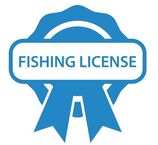
Other than that, you’ll also want to make sure you’re fishing within the law. Whether you’re casting from the docks or trolling offshore, you’ll need a fishing license. A daily license costs (BZ$20.|$10.USD), while a weekly permit will set you back (BZ$50.|$25.USD). You can get these online.
If you plan on making regular visits to Belize (which we highly recommend), you can purchase an annual license for (BZ$100.|$50.USD) For this permit, however, you’ll need to apply at the Coastal Zone Management Authority and Institute in person.
Belize is also one of the leading countries in Central America when it comes to conservation. All Bonefish, Tarpon, and Permit are catch-and-release only, so you’ll have to let these creatures go to fight another day.
If you plan on making regular visits to Belize (which we highly recommend), you can purchase an annual license for (BZ$100.|$50.USD) For this permit, however, you’ll need to apply at the Coastal Zone Management Authority and Institute in person.
Belize is also one of the leading countries in Central America when it comes to conservation. All Bonefish, Tarpon, and Permit are catch-and-release only, so you’ll have to let these creatures go to fight another day.

